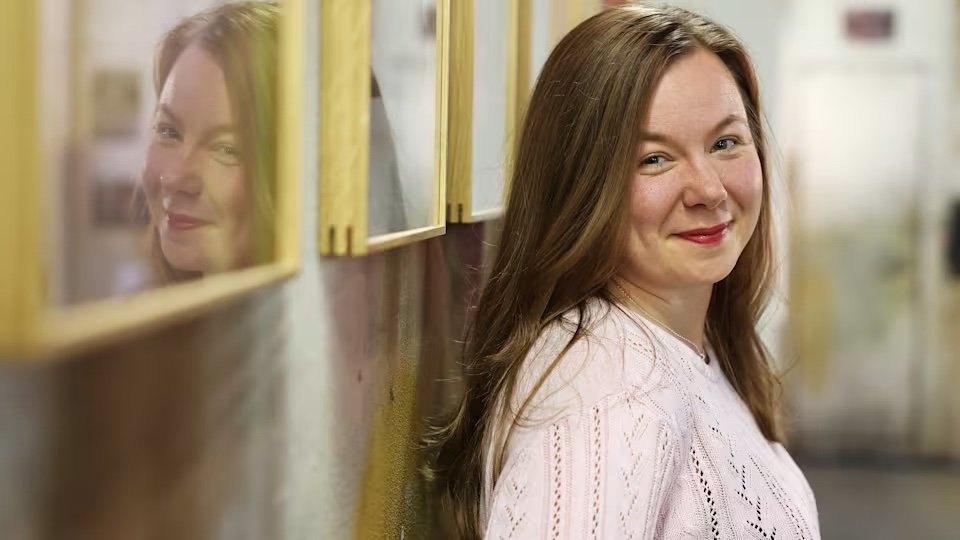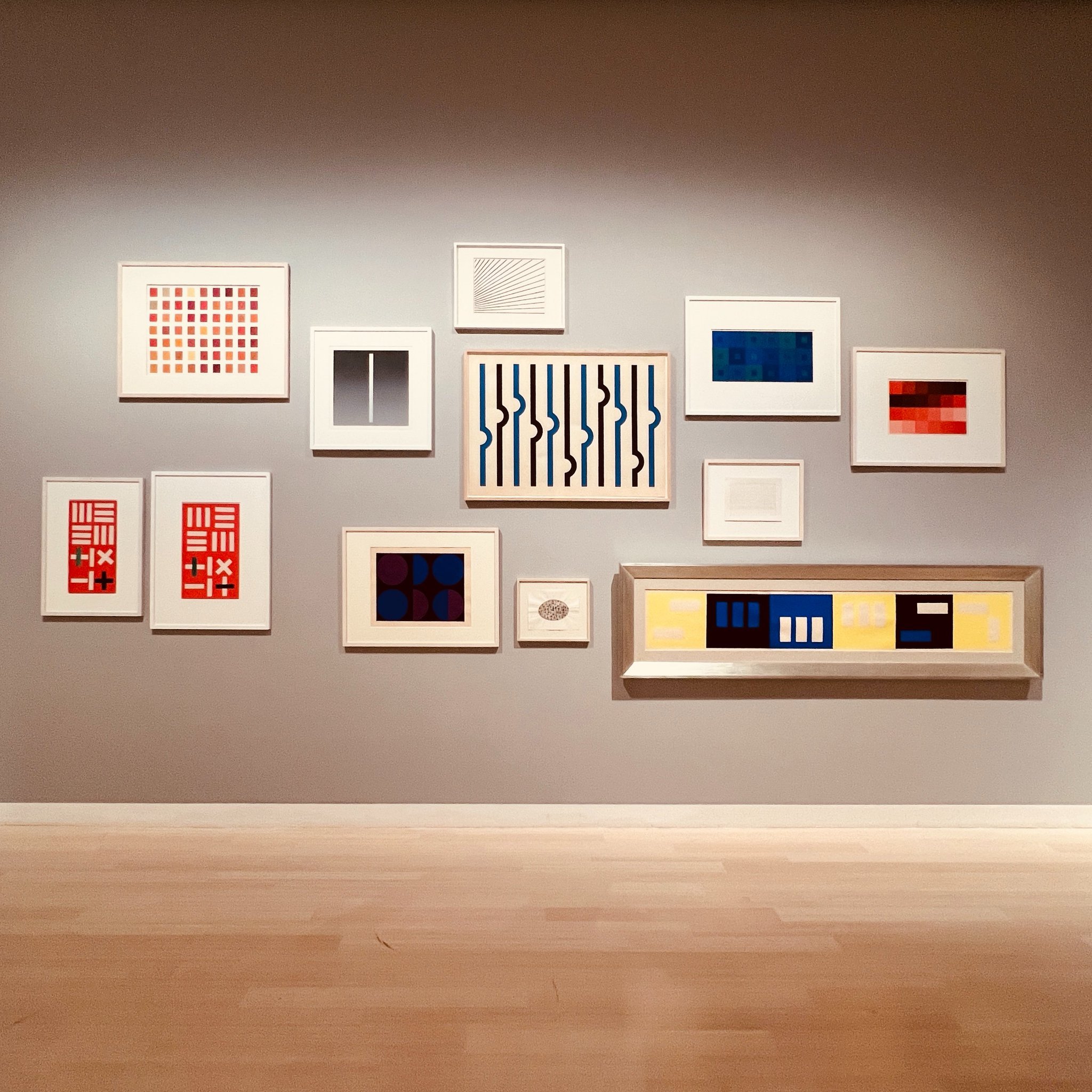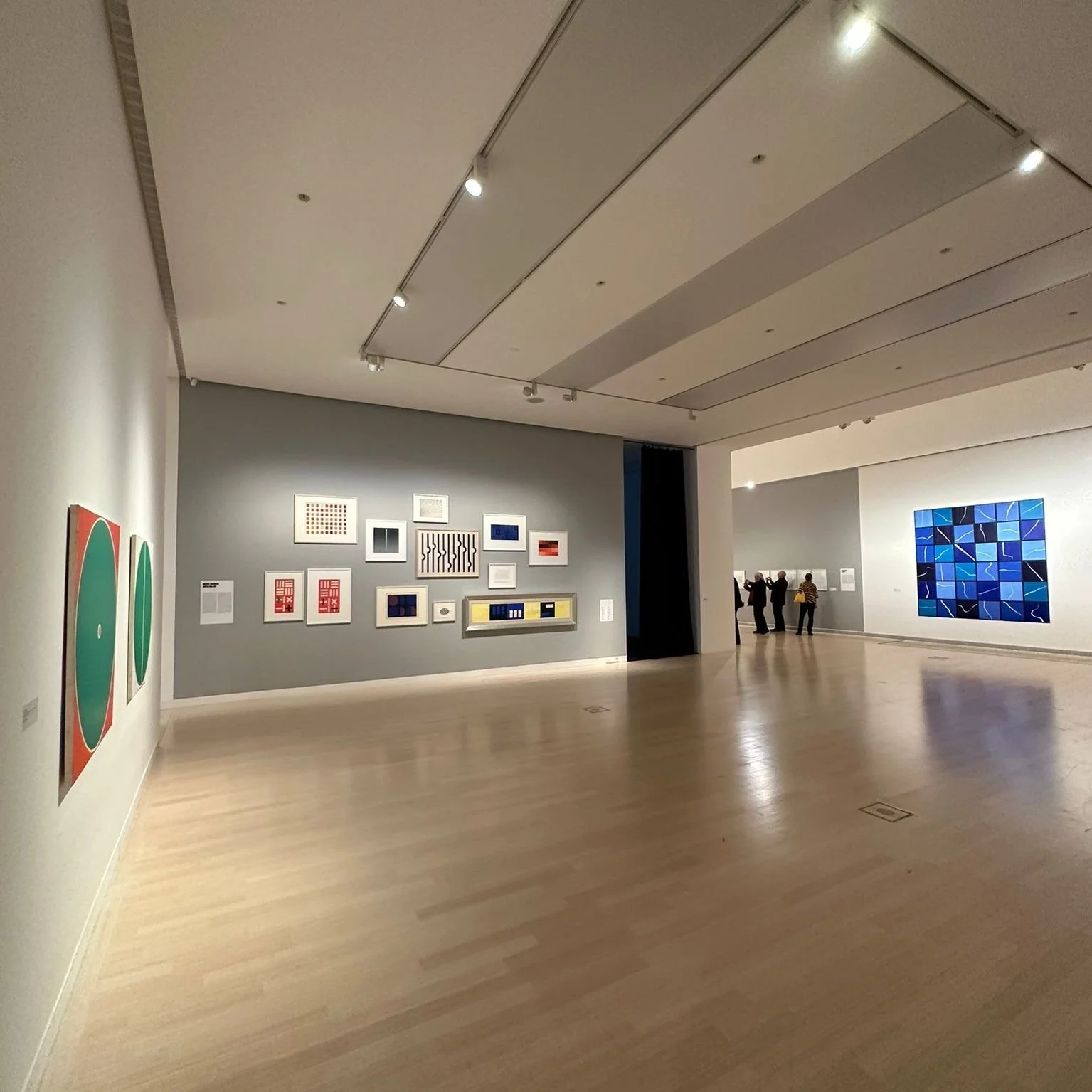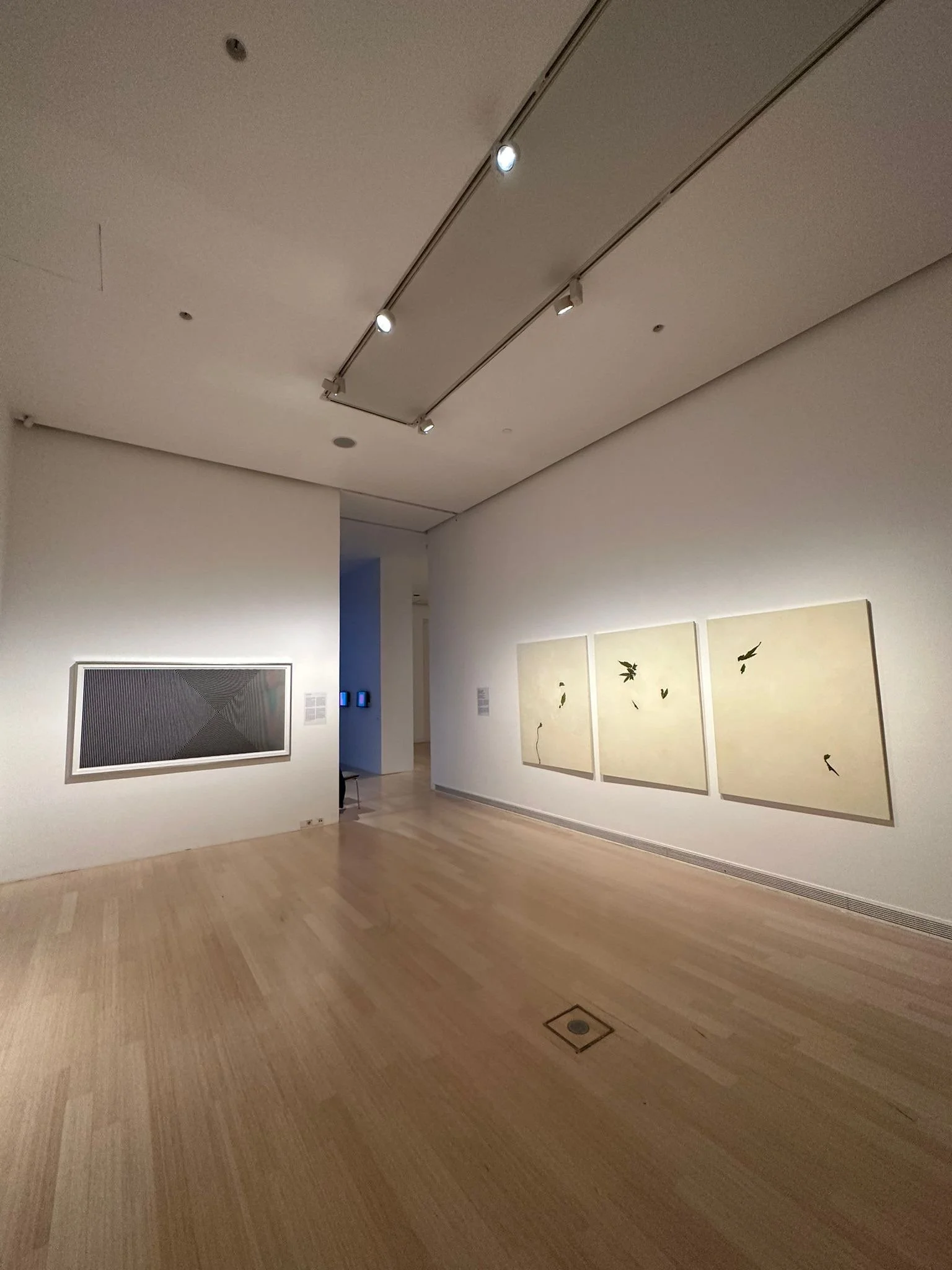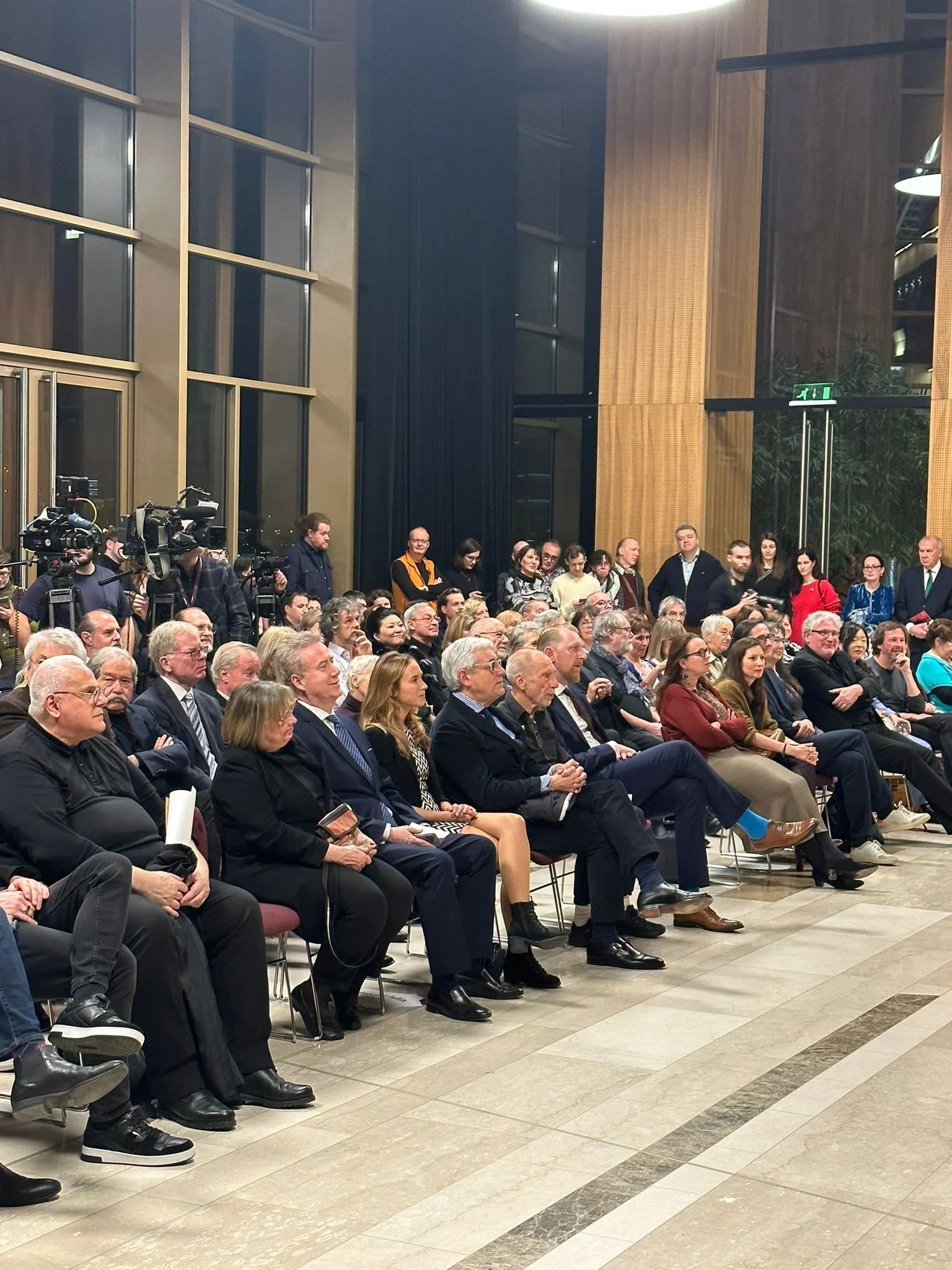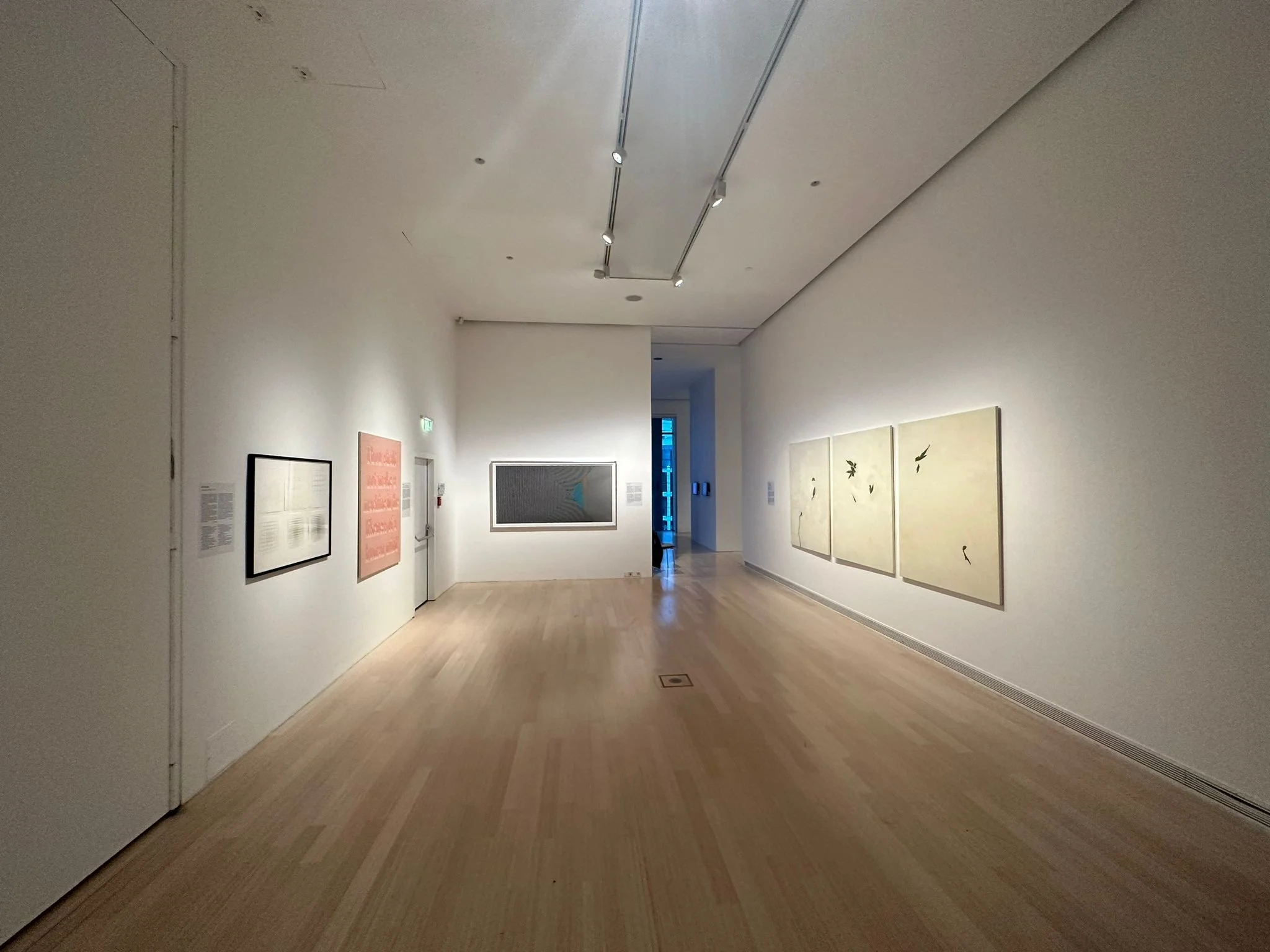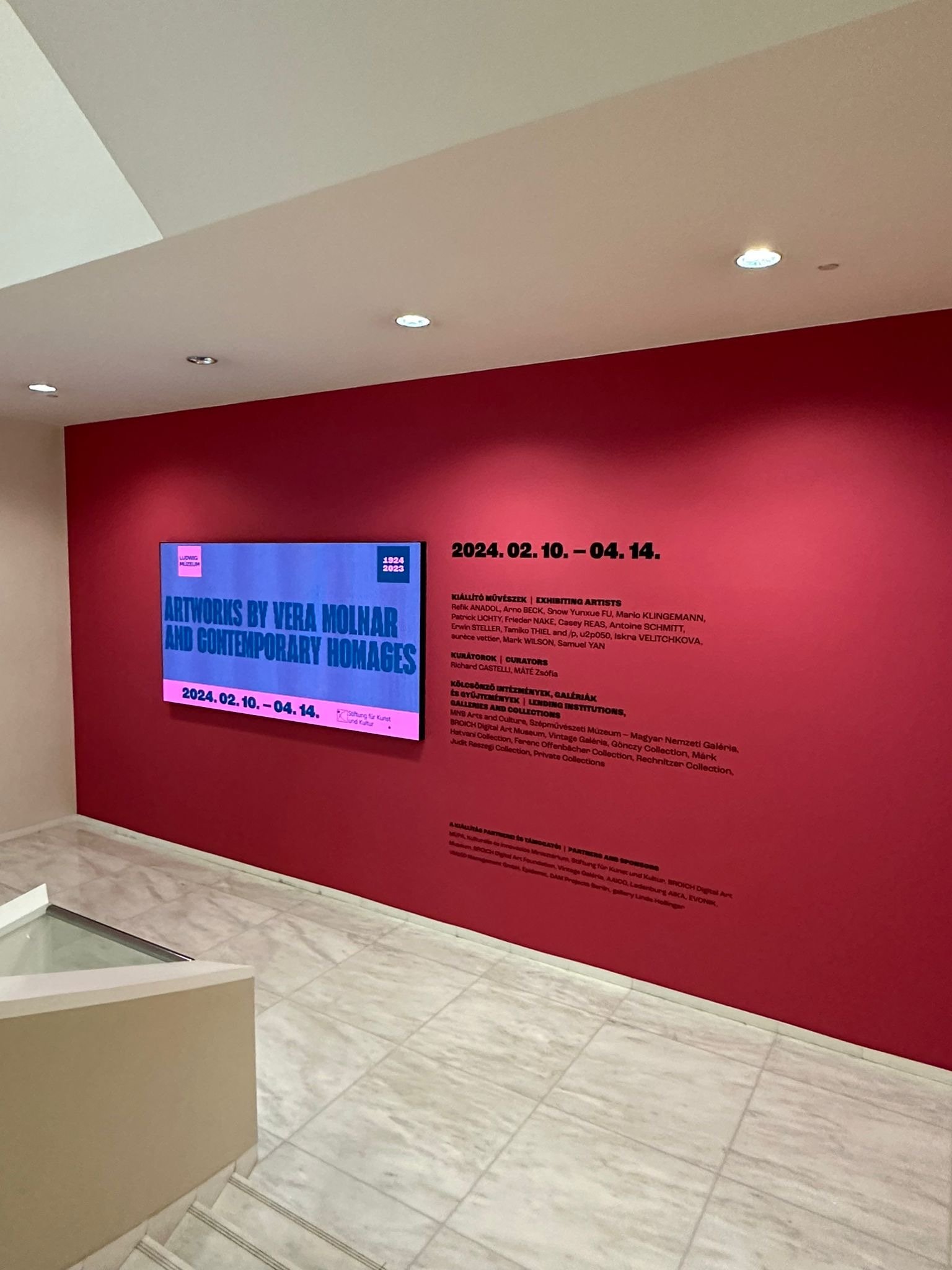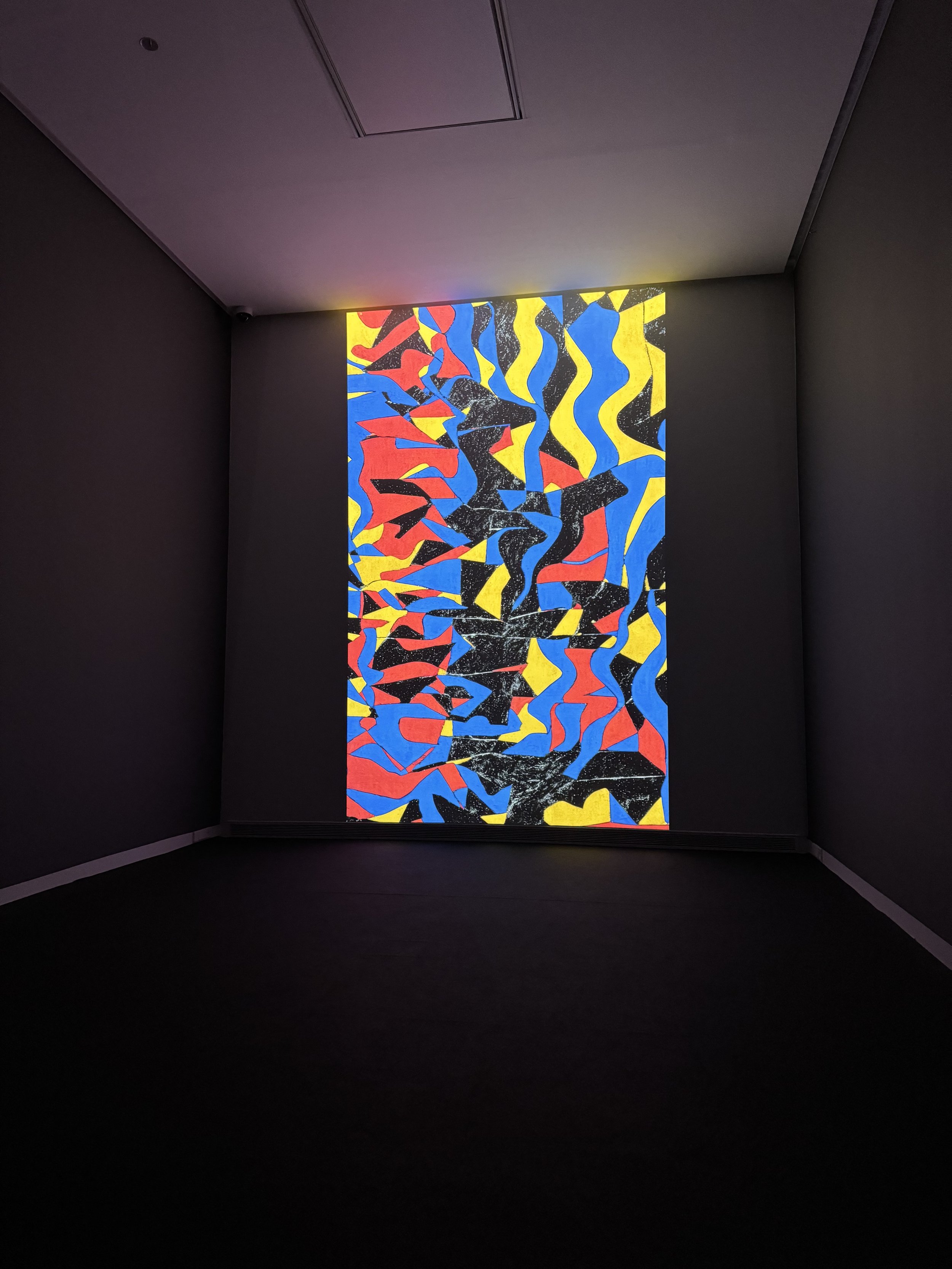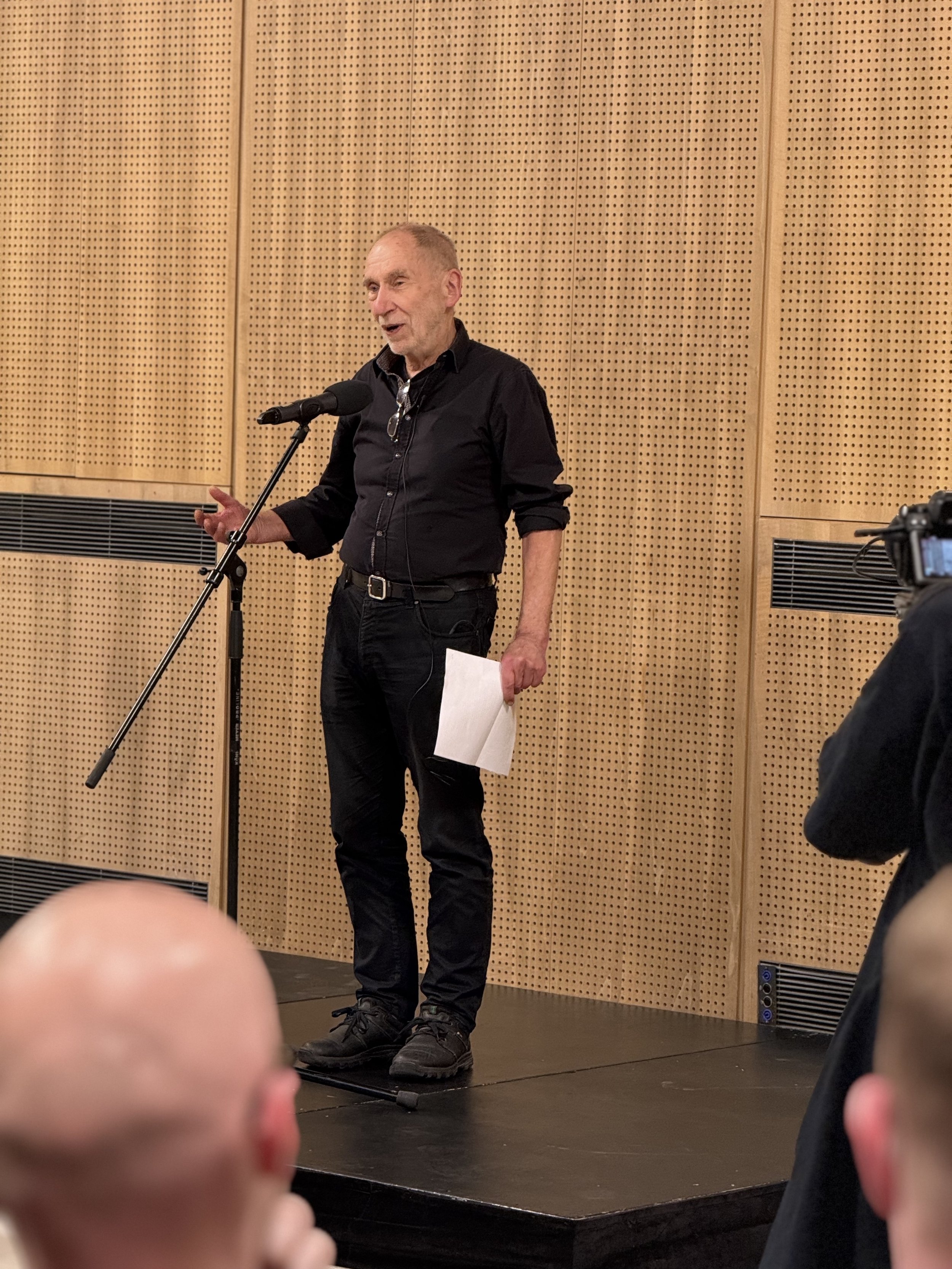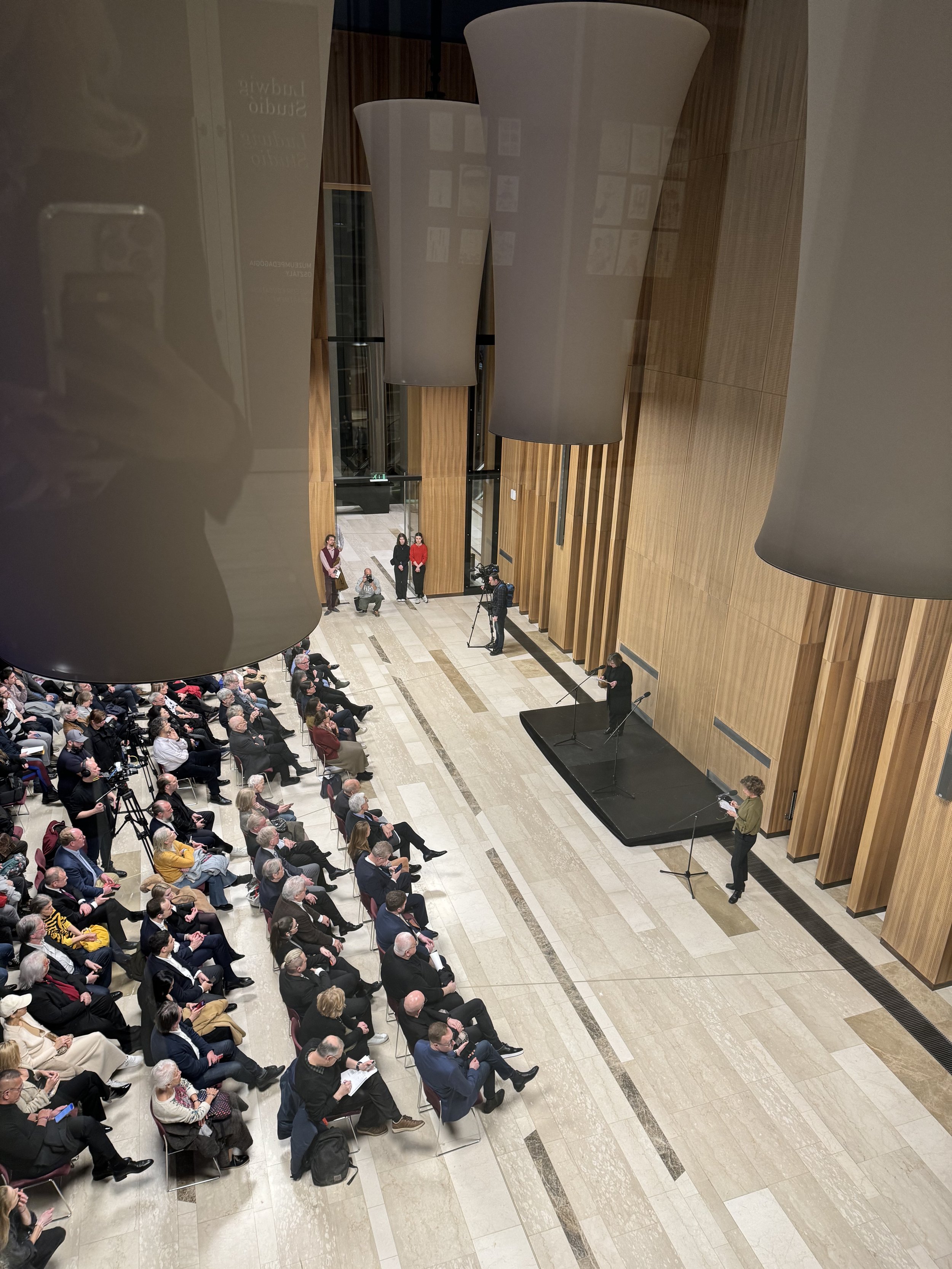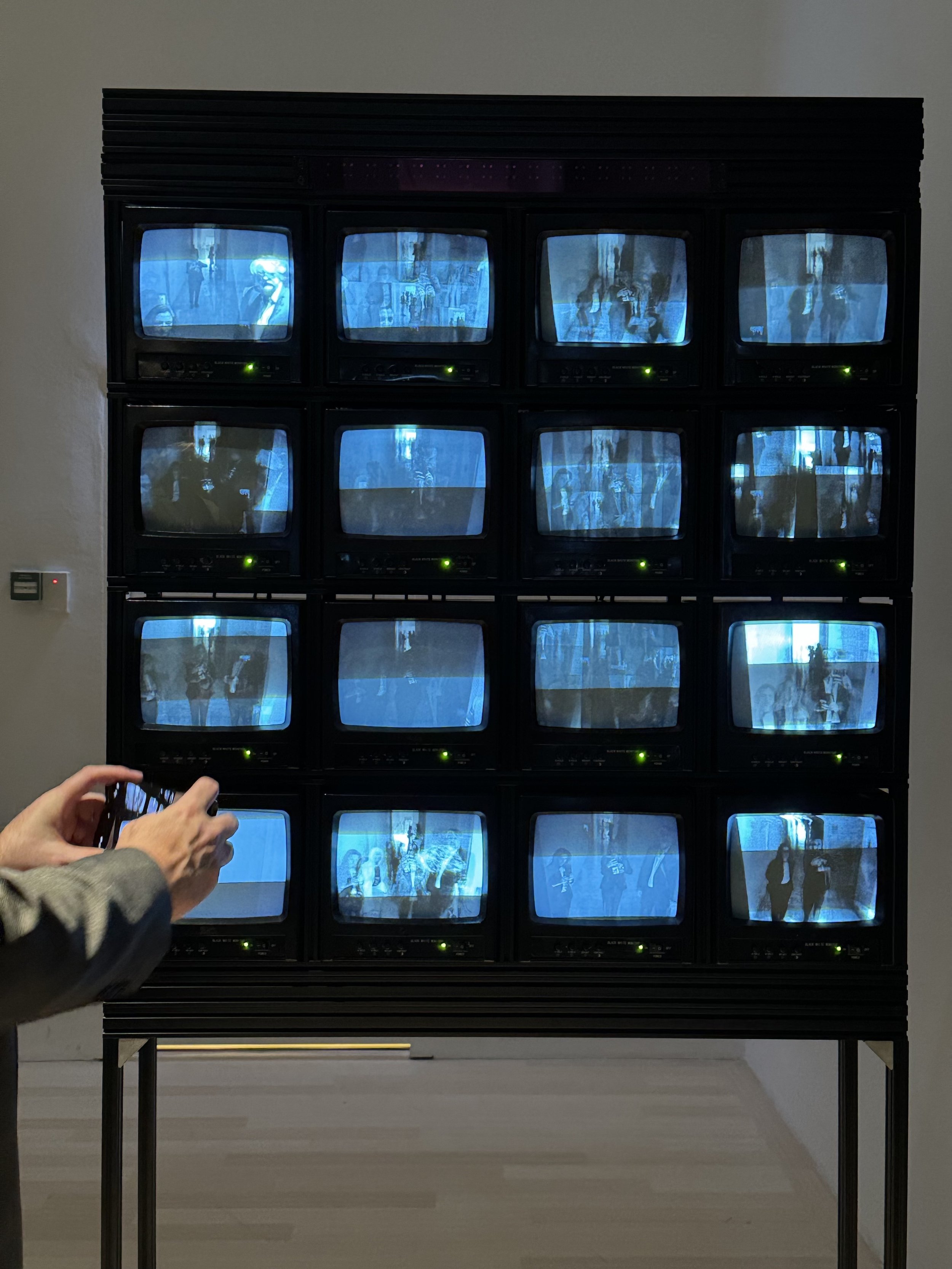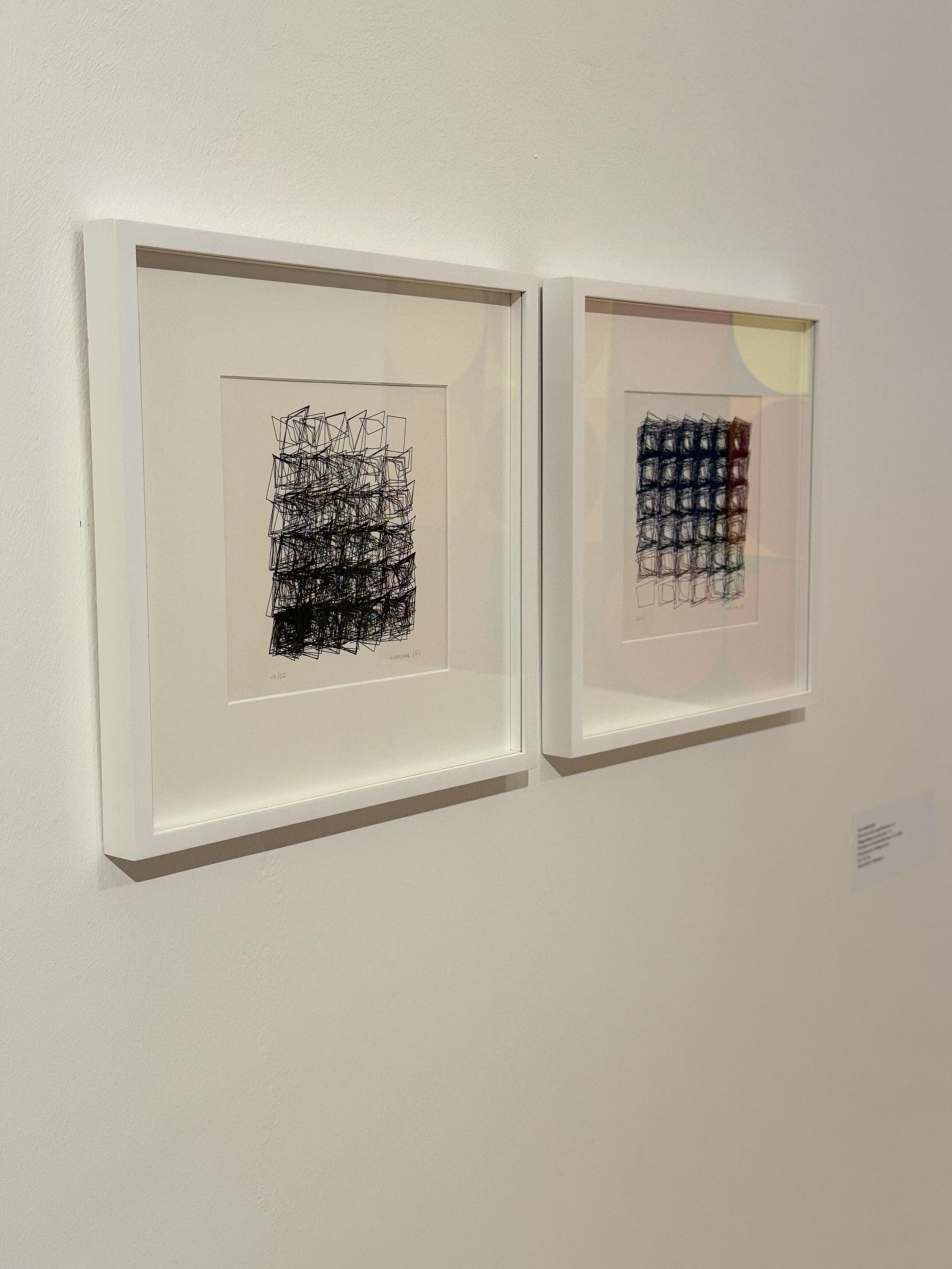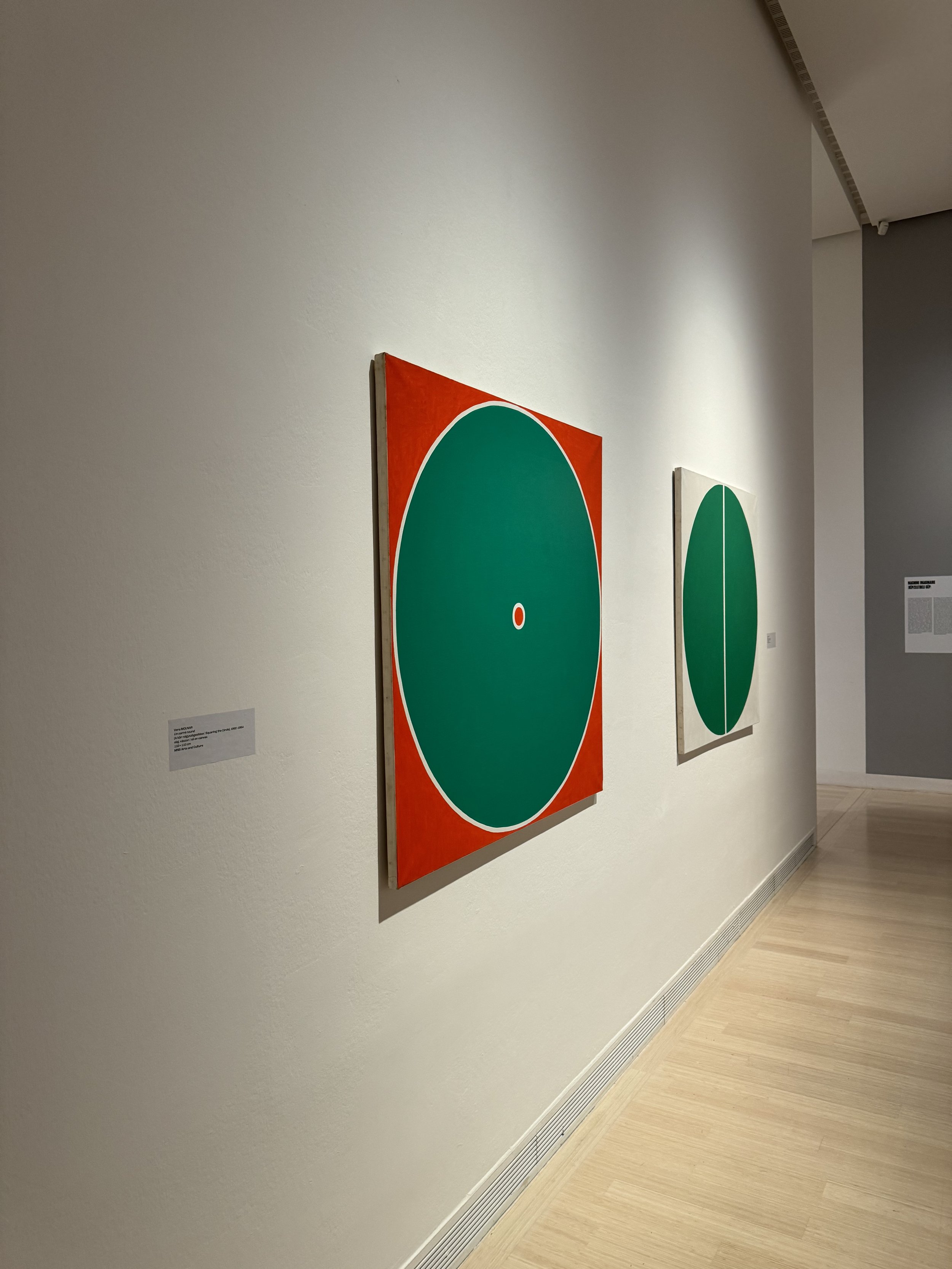Cornelia Sollfrank has been awarded the HAP Grieshaber Prize 2025
Published on April 9, 2025, by Jenny Fleischer at kunstfonds.de
Cornelia Sollfrank, //OG flowers// – 100 NFTs aus der Serie anonymous_warhol-flowers, NfTNeTArT – From Net Art to Art NFT, panke.gallery und Office IMPART, Berlin (2022)
The jury of the Stiftung Kunstfonds has awarded the “HAP Grieshaber Prize of VG Bild-Kunst”, endowed with 25,000 euros, to the artist Cornelia Sollfrank for her outstanding artistic achievement.
Cornelia Sollfrank (Berlin) is a visual artist, researcher and lecturer. Since the 1990s, she has been working with digital media and the paradigm shift that this entails in aesthetic practice and theory. Recurring themes in her work include critical authorship, new forms of (political) self-organization, artistic infrastructures and techno-feminism. With her numerous artistic projects and interventions, often realized within the framework of (techno-)feminist collectives, as well as her work in research and teaching, Sollfrank has earned herself a reputation as a pioneer of net art. In 1997, Sollfrank was one of the founders of the Old Boys Network (https://obn.org), in which female artists and researchers experimented with network structures and dealt with the articulation and implementation of cyberfeminism. The network organized several international conferences, the first of which took place as part of documenta X in Kassel. In 1999, Sollfrank also collaborated with programmers to create the net.art generator, which produces network art – collages of images available on the Internet – according to the ironically critical slogan “A smart artist makes the machine do the work” and supposedly turns every user into an artist. In her work cycle THIS IS NOT BY ME from the 2000s, Sollfrank explored originality and copyright in the digital world using the Andy Warhol work “Flowers”, thus anticipating questions of generative art that are being discussed again in the age of artificial intelligence. The multi-part work has been presented in exhibitions in Europe, Asia and North America.
Cornelia Sollfrank (*1960) studied painting at the Academy of Fine Arts der Munich and fine art at the University of Fine Arts Hamburg. Since 1998, she has taught at various international universities and art academies, conducted autonomous and institutional research and published on topics at the interface of art, technology and (gender) politics. In 2011, Sollfrank completed her practice-led research at the University of Dundee (UK) and published her dissertation “Performing the Paradoxes of Intellectual Property”. She has been involved in the technofeminist network #purplenoise since 2018. Sollfrank's art has most recently been shown in solo and group exhibitions at Studio XX in Montréal (2017), the Center for Art and Media (ZKM) Karlsruhe (2022), the Kunstmuseum Wolfsburg (2023), the Frauenmuseum Bonn (2024) and the Cooper Gallery Dundee, Scotland (2025). Further information about the artist: https://artwarez.org
By awarding the prize named after the painter and woodcutter HAP Grieshaber, VG Bild-Kunst is honoring an artist who was instrumental in the initiative to establish the German collecting society VG Bild-Kunst. Grieshaber had been extraordinarily committed to the copyrights of visual artists since the 1970s and had also vehemently advocated the expansion of social security for artists. The funding for the HAP Grieshaber Prize is provided by the Stiftung Kulturwerk of VG Bild-Kunst. They come from the proceeds that VG Bild-Kunst generates from the management of the copyrights of visual artists. The prize money is a recognition from artists for artists.
Kim Asendorf Solo Exhibition in Bangkok: COMPLEX
The Goethe-Institut Thailand presents Complex, the first retrospective exhibition of digital artist Kim Asendorf, which showcases the artist’s work from 2021 to early 2025, offering an overview of his contributions to generative and algorithmic art.
The pixel as a unit
With roots in net art, Asendorf’s practice sits at the intersection of conceptual visual systems, algorithms, and data manipulation. Writing his own code and contracts, his work merges generative art, glitch aesthetics, and conceptual approaches to digital media. Widely recognized for pioneering the pixel-sorting algorithm he first shared on GitHub in 2010, he has consistently evolved the boundaries of digital art. For Asendorf, the pixel is the atomic unit of digital art. He draws on the legacies of modern and contemporary artists who worked with systems, processes, and emergent visual forms, including pioneers of generative and algorithmic art such as Vera Molnár, Manfred Mohr, Lillian Schwartz, Herbert W. Franke and Frieder Nake. His approach echoes minimal and conceptual art practices, including instruction-based art, chance operations, and open processes, as well as abstract and op art, exploring geometry, seriality, and patterned compositions. Provoking critical reflection on software, networks, and online culture, he continues the work of early internet practitioners such as JODI. Merging chance and randomness, errors and glitches, repetition and seriality, signal and noise, his practice exposes the digital medium’s foundations and probes the conditions of contemporary digital media. Since 2021 he predominantly works with moving visual systems which are complex, absorbing, pulsing and mesmerizing.
Complex - a look back
The solo exhibition Complex at the Goethe-Institut in Bangkok is his first retrospective, covering the years from 2021 until the beginning of 2025. Unfolding across various spaces within the Goethe-Institut in Bangkok, including its garden, the show encompasses some of Asendorf’s seminal works.
Among the series on display are: Monogrid (2021), one of his first blockchain-based works, establishes a minimal yet mesmerizing aesthetic, with shifting grids and pixelated black-and-white patterns that evoke the language of early computer art. The series will be installed at the Goethe-Institut as an audiovisual multi-channel version. Sabotage (2022) visualizes the interplay between order and chaos, with rows shifting and a ‘saboteur ’moving pixels to manipulate patterns of grids, lines, and gradients, producing ever-changing arrangements. Alternate (2023) shows a growing complexity in compositional layering and color interplay with pulsing glitch effects and dynamic distortion. PXL DEX (January 2025) extends his abstract animations into architectonic, dense and object-like 3D systems.
Leading up to the exhibition, Kim Asendorf will be conducting a peer-to-peer workshop on code-based digital art at the Goethe-Institut in Bangkok. The working group’s exhibition will follow later this year.
Kim Asendorf Exhibition - COMPLEX
Date: 29 - 30 March 2025
Location: Goethe-Institut Thailand, Sathorn 1 Bangkok
Ivona Tau Explores Memory and AI in Somewhere, Something Shines exhibition
We are excited to share that our artist Ivona Tau is an exhibiting artist in Somewhere, Something Shines, alongside Anna Fraire at Galerie Met. Exploring the fluid and changing nature of memory, Somewhere, Something Shines brings together Fraire’s physical collages and Tau’s AI reinterpretations of archival works. Ivona Tau’s pieces transform personal history through machine learning by training neural networks on old family photographs and film. The exhibition opens on March 14 and runs until April.
Ivona Tau, After-school social club, 2025
A family album is more than a collection of images—it is a vessel of memory, a silent witness to lives once lived, relationships formed, and moments that shaped generations. Some memories remain vivid, while others fade into fragments, altered by time, emotion, and forgetting. In Somewhere, Something Shines, Anna Fraire and Ivona Tau engage with these traces of the past, transforming their family archives through distinct yet complementary approaches. Fraire reconstructs memory through physical collage, incorporating photographs with intimate artifacts, while Tau entrusts artificial intelligence to reinterpret her family’s history, training neural networks on archival images and film. Their works embody the tension between holding onto the past and allowing it to evolve, revealing how remembrance is not static but continuously reshaped by time, technology, and perception.
Anna Fraire approaches memory as a layered and evolving process. In her series Family Album / Album di Famiglia, she reconfigures old family photographs by combining them with personal documents, letters, postcards, and school reports. These elements intertwine in compositions that do not reconstruct her family’s history but rather explore the fluidity of memory. Fraire’s work highlights how memory is not an ordered archive but a shifting terrain where past and present, personal experience and testimony, constantly blur.
Ivona, Tau Bird cherry blossoms in the summer of 1967, 2025
Her process embraces imperfection and transformation, demonstrating that memory is not about restoring the past but engaging with its remnants. By working with inherited materials and disrupting traditional photographic storytelling, she challenges the notion of history as something fixed. Instead, her compositions invite viewers to consider how memory functions beyond mere documentation, existing in layers of meaning that shift over time. Through the family archive she works with, Fraire explores the interplay between presence and absence, joy and hurt. Transcending the personal, she traces the connections between us and our emotional legacies, opening up new perspectives on what is inherited and reinterpreted across generations.
Ivona Tau, working at the intersection of photography and artificial intelligence, explores memory through digital reconstruction. In her series My Grandmother’s Memories, she processes a collection of negatives and 8mm film footage taken by her grandfather in the 1960s and 1980s, training AI models to reinterpret these archival images. The AI-generated results— faces that resemble family members but are never exact, moments that feel real yet remain elusive—evoke the fragility of memory and its tendency to blur over time. Her approach reflects the way recollection is unstable, subject to distortion, and shaped by both human perception and technological mediation.
Ivona Tau, Castles of Antakalnis, 2025
Tau’s work extends beyond her grandmother’s memories to broader reflections on the impermanence of personal history. As her grandmother experienced memory loss—mistaking loved ones, inhabiting a past that no one else could see—Tau became fascinated by how memory fragments and reshapes itself. AI’s generative glitches—its distortions, shifting forms, and fluid reconstructions—mirror this process, highlighting the instability of remembrance. Her works, including After-School Social Club and Longing for an Embrace, Longing for a Gaze, explore how artificial intelligence can serve as both an archival tool and a metaphor for the ways memory is reconstructed through personal and technological lenses.
Through Fraire’s tangible, layered assemblages and Tau’s digital reinterpretations, Somewhere, Something Shines reveals
memory as an active, ever-changing force. Whether through the physical remnants of personal history or AI’s generative reimagining, both artists expose how remembrance is shaped by materiality, perception, and time. Their works question the boundaries between preservation and reinvention, personal and universal, nostalgia and transformation. In an era when digital technology increasingly mediates how we remember, this exhibition serves as a reflection on the fragile, fluid nature of memory—one that is always shifting, always becoming, always shining in unexpected ways.
Somewhere, Something Shines
Anna Fraire, Ivona Tau
Opening: March 14, 2025, 18:00 – 21:00
Exhibition: March 15 – April 05, 2025
Mariannenstrasse 33, 10999 Berlin
Collaborator: Fellowship
Ivona Tau, My Grandmother’s Memories, 2025
Anna Fraire:
Anna Fraire is an art photographer with a background in architecture. She studied at Berlin’s Neue Schule für Fotografie, where she developed her experimental approach to photography. Her work explores a wide range of personal themes, from womanhood and body image to perception, memory and emotional inheritance. Often incorporating mixed media, analogue photography and digital manipulation, she combines unconventional tools and materials to create images that convey a sense of depth and complexity, encouraging viewers to question their own perceptions of reality. Her work has been exhibited internationally in various shows including Signs of Impermanence at Jinny Gallery in Tokyo (April 2023), International Festival For Alternative Photography at Multimedia Center Mala Stanica in Skopje (July 2023), and StadtWandel at Fotogalerie Friedrichshain in Berlin (February 2021). She has been featured in several publications, including Art Doc Magazine (September 2023, September 2020), Yogurt Magazine (Quarantine Flavour, June 2020), and was shortlisted for Fotoroom Vasli Souza Edition in 2019.
Ivona Tau:
Ivona Tau is a new media artist from Vilnius, Lithuania, who combines code, deep neural networks, and personal memories embedded in photography. Her goal is to find and evoke emotions through artificially intelligent tools. Working at the intersection of photography and machine learning, Tau explores how AI reinterprets visual memory, capturing the tension between human perception and algorithmic reconstruction. Her practice is rooted in the materiality of photographic archives, using generative models to distort, reshape, and reimagine images, revealing the imperfections and fluidity of recollection. By training her own models on personal datasets, she maintains control over the aesthetic and conceptual direction of her work. Tau’s work has been exhibited widely, including Art Basel Miami Beach, SCOPE, CAFA, Art Week Shenzhen, Vellum, Bitforms New York, Venus Over Manhattan, The House of Fine Art, Bright Moments Berlin, Christie’s New York and Sotheby’s New York. Her work has been acquired by ZMK Museum of Contemporary Art in Germany & Francisco Carolinum Linz in Austria.
Laura Rautjoki Exhibits in History Reimagined at the Colorado Photographic Arts Center
We are excited to announce that Laura Rautjoki is among the exhibiting artists in the History Reimagined exhibition presented by the Colorado Photographic Arts Center in collaboration with the Month of Photography Denver Festival. Curated by Samantha Johnston, the show features works by Laura Rautjoki, Todd Dobbs, and Phillip Toledano who explore the role of AI in photography and how it challenges our perception of truth, historical narratives, and visual representation.
Works by Laura Rautjoki at History Reimagined in the Colorado Photographic Arts Center, curated by Samantha Johnston © Colorado Photographic Arts Center
Photography has long been known as a medium for documentation and storytelling. With the emergence of AI-generated art, the line between real and constructed has become increasingly difficult to define. History Reimagined examines the role of historical memory in photography and AI, confronting the biases present in both archival images and algorithmic processes. Through their work, the artists raise critical questions about authenticity and the relationship between technology and visual culture.
Laura Rautjoki, a visual artist and photographer, presents her works that investigate the representation of Finnish women in photographic history from the 1960s to the present. Using AI technology, she creates alternative views that challenge traditional portrayals of women, often depicted from a male perspective in early photographic works. Laura uses AI not only to capture the essence of her subjects and free them from this perspective but also to convey melancholic Finnish ambience that is evident in her pieces.
Works by Laura Rautjoki at History Reimagined in the Colorado Photographic Arts Center, curated by Samantha Johnston © Colorado Photographic Arts Center
CURATOR’S STATEMENT
In History Reimagined, photographic artists Todd Dobbs, Laura Rautjoki, and Phillip Toledano explore how Artificial Intelligence (AI) can shape our perceptions of truth. By harnessing AI, they challenge traditional notions of photographic authenticity, demonstrating how technology can both reflect and alter our understanding of the world.
Photography has long been considered a tool for documenting and understanding the world around us. But as these artists show, the rise of AI forces us to reconsider the very nature of truth in image-making. History Reimagined invites us to examine the complex relationship between image-making, bias, and historical memory, and to ask ourselves: How do we define truth in a world where the lines between real and fabricated are increasingly hard to discern?
Todd Dobbs’s work engages directly with the inherent biases embedded in AI’s algorithms. By prompting the AI with the phrase “photograph of a typical American,” Dobbs highlights the limitations and stereotypes that persist. Despite running the same prompt countless times, the resulting images are uniformly American, white, and suburban—a visual echo of dominant cultural norms. Dobbs is interested in AI’s ability to generate, interpret, and transform opening doors to imaginative realms that challenge conventional boundaries.
In contrast, Laura Rautjoki’s The Image of a Woman subverts historical portrayals of Finnish women, using AI to create alternative depictions. Drawing from her own identity and the historical imagery of Finnish women, Rautjoki’s work reimagines femininity outside of the male-dominated narratives that have shaped much of art history. Using AI, she creates alternative perspectives on the portrayal of Finnish women, allowing them to break free from the viewer’s expectations
Phillip Toledano’s Another America explores the fragility of truth in an age where the boundaries between reality and fiction are increasingly blurred. This series imagines an alternative version of New York City in the 1940s and 50s, telling a history that never was, built upon fictional stories penned by New York Times bestselling author John Kenney. In an era where AI-generated imagery can fabricate entire realities, Toledano’s work reflects on how easily visual evidence can be manipulated, offering a stark warning about the power of images to shape our beliefs, our identities, and even our understanding of the past.
As a curator, I am particularly interested in how these works provoke conversation at the intersection of art and technology. And as a center for photography, I feel that we must acknowledge and respond to the technological innovations that are transforming the medium. History Reimagined is a conversation about the future of image-making, the impact of technology on our visual culture, and the urgent need to critically engage with the images that shape our world.
— Samantha Johnston, CPAC Executive Director & Curator
The exhibition runs from March 1 to April 12, 2025, at the Colorado Photographic Arts Center in Denver. The opening event will take place on March 1 from 6 to 9 pm, followed by a panel discussion on March 2 at 1 pm, where the artists will engage in a conversation moderated by curator Samantha Johnston.
Works by Laura Rautjoki at History Reimagined in the Colorado Photographic Arts Center, curated by Samantha Johnston © Colorado Photographic Arts Center
Interview with Kevin Abosch in Corriere della Sera
Written by Clelia Patella, published in Corriere della Sera (https://www.corriere.it/)
The Italian magazine Corriere della Sera recently sat down with Kevin Abosch for a conversation about his artistic practice. In this interview, Abosch discusses some of his most well-known works, including Potato, I Am a Coin, Priceless, and his film Am I, while also sharing his thoughts on the future of AI-generated art. We are pleased to present the English translation of the article.
On the day Maurizio Cattelan’s banana was sold at auction by Sotheby’s for $6.2 million, the city of Lugano was celebrating digital artist Kevin Abosch at the Synthetic Program exhibition at Valuart Gallery. In 2015, Abosch sold his photograph Potato #345 for over $1 million. These two seemingly ordinary food items – the banana and the potato, in their respective contexts, challenge the conventions of the art market and question what truly defines a work of art.
While Cattelan uses surrealism and humor, Abosch takes a more direct approach: value is no longer tied to the physical object itself but to the idea behind it. In an era where technology is redefining the boundaries of art and its accessibility, Abosch’s photographed potato is a reflection on how we assign meaning and value to art.
Kevin Abosch, 56, is an Irish artist who was featured on the cover of la Lettura (#681) on December 15. He is best known for his portraits of Hollywood celebrities, including Johnny Depp and Yoko Ono. A decade ago, he shifted his artistic focus, turning everyday objects into subjects of his work. A pioneer of Crypto Art, his practice spans photography, sculpture, installations, artificial intelligence, and video. We interviewed him.
CdS: In 2015, you sold a photograph of a potato for $1 million. How do you view the relationship between value and perception in art?
KA: In my artistic practice, I find it fascinating to challenge conventional notions of value. However, I prefer not to engage with the mechanics of the art market. I would never create work with commercial success as the goal—doing so would mean failing in my pursuit of meaningful art.
CdS: You explore the boundaries between the physical and the digital. How do you see the future of art in an increasingly immaterial world?
KA: Art is art, whether physical or digital. For those under 40, engaging with the immaterial feels natural, whereas older generations often struggle to understand how something intangible can hold value. The rise of NFTs has provided an opportunity to challenge these preconceptions. People collect art for three main reasons: to share space with it and experience an emotional connection; to gain social validation; and as an investment. These motivations apply equally to both physical and digital art. Ultimately, the most important factor is the emotional connection—if an artwork resonates with someone, its material form becomes irrelevant.
CdS: In the project I Am a Coin, you "tokenized" yourself, effectively becoming a cryptocurrency. What motivated this decision?
KA: I Am a Coin was born from my growing sense of being treated as a commodity rather than as an artist. The focus had shifted from the artistic value of my work to its financial worth. By tokenizing myself, I aimed to reclaim control of the narrative—but ironically, the tokens themselves became objects of exchange. It’s a paradox that reveals an intriguing reality.
CdS: In 2018, you collaborated with AI Weiwei on Priceless, a project that created two tokens—one inaccessible and the other with an infinitesimally small fractional value. How has the concept of ownership evolved in an era where art and value are increasingly fragmented and virtualized?
KA: Today, an artwork can be divided and distributed through blockchain, enabling a new form of access—not just financial, but also experiential. This shifts the focus from individual ownership to collective participation. As a result, the very idea of ownership becomes more fluid, transforming into a shared experience.
Kevin Abosch, Potato #345, 2010
CdS: In your film Am I?, you explore transhumanism and the role of artificial intelligence. What are the key opportunities and ethical challenges?
KA: I don’t see artificial intelligence as a being—I consider it a tool, not a collaborator. If used wisely, AI can even help us uncover deeper aspects of ourselves. However, the greatest danger lies in immersing ourselves too deeply in the 'consciousness of the machine' and losing part of our humanity. That’s why, when I feel the boundary between myself and the machine becoming too thin, I step back. I paint, reconnect with the physical world, and return only when I feel grounded in my own humanity again.
CdS: AI-generated art is often perceived as a threat to traditional art. How do you respond to this?
KA: It reminds me of those who criticize my synthetic photographs, arguing that they diminish the value of 'real' photography. But photography, by its very nature, is an illusion—a reproduction of reality. Paradoxically, a synthetic image can sometimes be more truthful and revealing than a traditional photograph. What’s crucial is developing a deep understanding of technology and recognizing its potential for misuse. In the future, true power will not be measured by economic wealth but by technical expertise. Only by mastering these tools can we prevent AI from being weaponized against us.
CdS: We are witnessing a digital transformation that is rewriting the rules of culture. What do you find most compelling about this shift?
KA: Artists and philosophers will serve as guides in this complex, AI-driven future. Those of us working with AI in art act as mirrors for contemporary ethical and social dilemmas, addressing issues such as copyright, personal security, and identity.
CdS: What are the most exciting frontiers for digital art?
KA: We are entering the era of living art. Works will no longer be static but will evolve over time, sometimes in unpredictable ways. This shift will fundamentally change the relationship between the artist, the artwork, and the collector, overturning the traditional dynamic of control.
CdS: Digital art is often dismissed as "not real art." However, you argue that the value of art lies in the idea. How do you assign value to something that cannot be touched or hung on a wall?
KA: Many struggle to grasp that digital art is no less ‘real’ than a painting or sculpture. The value of art lies in the idea and the emotion it evokes. Technology is simply a tool—one of many—that translates that idea into a form we can engage with and understand.
CdS: Your latest work is a short film created entirely with AI. Do you think artificial intelligence will eventually dominate the future of cinema?
KA: Everyone wonders when Hollywood will start producing films entirely powered by AI. But I don’t think even James Cameron and his top technicians can achieve what I can—perhaps while sitting naked in bed with just a laptop. Technology is pushing the boundaries of cinema, but its full potential will only be realized as both the tools and the skills to use them continue to evolve.
“Interthinking” on Screen - M5’s Kunszt Highlights Our Exhibition
Aired in Kunszt on M5 on 17.02.2025, Edited by: László Merkl & Áron Palkó
We are pleased to share that Kunszt, the cultural program of M5, a Hungarian television channel, recently visited the Interthinking exhibition at Budapest Art Factory and featured it in their latest episode. The program explored the theme of waves and vibrations, presenting exhibitions that examine these phenomena from various artistic perspectives.
Artistic influences function similarly to waves—ideas and creative impulses originate from a single point and expand outward, influencing new thoughts and artistic directions. Some artists generate particularly strong waves of influence, which resonate with others and shape new artistic approaches. "Interthinking" examines this process, tracing connections between past and present artistic practices.
The exhibition celebrates the impact of Hungarian cultural heritage and artists on the international generative art scene. The title “Interthinking” is inspired by a concept from György Kepes that emphasizes collaboration between humans and technology and the dynamic relationship between art and science. The curatorial program pays tribute to Hungarian artists, such as László Moholy-Nagy, Victor Vasarely, Nicolas Schöffer, György Kepes, Vera Molnár, Brassaï, and André Kertész, who integrated technology into their work, shaping new directions and inspiring the conceptual foundation of the generative and AI art field. Visitors can explore the art of these pioneers through documentary films and artworks. The artworks were lent by Ferenc Offenbacher, founder and director of the Kepes Institute.
In addition to Hungarian historical figures, the show features works by seven international contemporary generative talents, including Iskra Velitchkova, Marcelo Soria-Rodríguez, Kevin Abosch, Laura Rautjoki, Mario Klingemann, Studio u2p050, and Julien Gachadoat. Each piece was created specifically for this exhibition and reflects on the themes and breakthroughs of these Hungarian masters.
Laura Rautjoki's work Airy at Hagelstam & Co.'s auction
Laura's work Airy (1/1 + AP) AP edition is for sale at Hagelstam & Co.'s modern art auction T156. Airy is part of The Image of a Woman, a 14-piece exhibition series that will next be showcased at the Colorado Photographic Arts Center in March-April 2025 as part of the Month of Photography event. Laura created Airy using artificial intelligence as part of this series, in which she explores the representation of Finnish women in photographic history.
Hagelstam & Co is one of Finland's most significant auction houses, particularly in the trade of art, antiques, and design objects. It has been in the industry for over 40 years and has established itself as one of the leading players in the field in Finland.
The works surrounding Laura's piece are by Pentti Sammallahti, Santeri Tuori, and Matti A. Pitkänen.
AI and the Role of Digital Art in Addressing Social, Political, and Environmental Issues
During the recent Untitled Art Fair in Miami, we had the privilege of participating in an engaging panel discussion on AI and the role of digital art in addressing social, political, and environmental issues. The panel was moderated by Kate Vass and featured esteemed speakers, including Kevin Abosch, Sasha Stiles, and Ivona Tau, alongside Adam Berninger of TENDER.
As digital art continues to expand its influence, the integration of AI is opening new avenues for artists to explore and comment on critical global issues. This panel brings together distinguished artists, curators, and thought leaders to examine how AI enables digital artists to create works that provoke thought and inspire change across social, political, and environmental contexts. Panelists will discuss digital art’s unique power to raise awareness and shape public opinion on pressing global concerns while also exploring the ethical considerations artists face when using AI to engage with sensitive topics. By the end of the discussion, the talk aims to highlight the potential of AI-driven digital art to contribute to meaningful conversations and actionable solutions to today’s most urgent challenges.
This panel discussion is moderated by Kate Vass of Kate Vass Galerie and features artists Kevin Abosch, Sasha Stiles, and Ivona Tau, alongside Adam Berninger of TENDER, and was recorded at Untitled Art, Miami Beach 2024, on December 7, 2024.
Laura Rautjoki creates art using artificial intelligence, a rarity in the art world
Writer: Vesa-Matti Ruuska, published in YLE on November 16 at 5:32 PM.
The article was originally published in Finnish and translated into English by Kate Vass Galerie.
Source: yle.fi
While AI-generated images have taken social media by storm, their use in fine art remains limited, partly due to ethical concerns surrounding the technology.
The images featured in this article are from Laura Rautjoki's series The Image of a Woman, which explores the portrayal of Finnish women throughout photographic history. However, these are not traditional photographs—they were created using artificial intelligence. “I’ve intentionally left some of the AI’s mistakes visible. For example, some figures have disproportionate features,” Rautjoki explains at the Amiraalistonkatu Warehouses in Turku, where her works are on display until the end of November.
While many online AI tools enable anyone to generate images, Rautjoki’s creations have been exhibited in a museum in Finland and a gallery in Budapest. What distinguishes these works as art? According to Rautjoki, it’s her perspective as a trained artist and photographer with over a decade of experience. She uses AI as a tool to express her unique visual language. “I feel like I’ve truly found my voice through AI-generated imagery,” she says.
“Airy" is one of the early images from Rautjoki's AI project. "The image demonstrated that AI can bring even the wildest photographic visions to life," she says. Image: Laura Rautjoki
Researcher: The Final Result Must Be Controlled by Humans
Determining the artistic value of AI-generated works is not straightforward, says doctoral researcher Iikka Hauhio. One way to assess their value is to consider whether the final result is controlled by AI or by a human. For human control, three key conditions must be met: the ability to guide the AI, ensure the AI’s predictability, and allow the human to express themselves through it.
“A camera takes predictable photos, a pen draws predictable lines, and an instrument produces predictable sounds. AI, however, is often unpredictable,” explains Hauhio, who studies computational creativity and art-generating programs at the University of Helsinki.
The artistic value of AI-generated images is further challenged by the ease with which they can be mass-produced. Even if an individual image is aesthetically strong, its value diminishes when similar images can be created in unlimited quantities.
According to Hauhio, AI can indeed create art, but only when the final result remains clearly under human control. He uses music as an example: a musician might ask AI to generate samples—short audio clips—and then integrate these into a song. “In that case, the artistic value comes from the human’s mixing and composition, which gives the work its significance,” Hauhio explains.
Another approach is to use AI iteratively, generating multiple outputs from the same concept to refine the result. The human retains control by adjusting the inputs provided to the AI, shaping the final outcome. This method is also employed by Laura Rautjoki in her series. Below are examples of AI-generated images that, after input adjustments, became part of the work Getting Ready for School.
"They Know Me" depicts "prosperous women in the Forssa region in the early 1900s." These images are part of Rautjoki's thesis for her Master’s degree at Turku University of Applied Sciences. Image: Laura Rautjoki
Use of AI in Visual Arts Still Limited
The use of artificial intelligence in contemporary art remains limited, with only a small number of artists identifying as "AI artists," says Tuomo Rainio, a lecturer at the Academy of Fine Arts at the University of the Arts Helsinki. “For an artist, automating their work process isn’t particularly meaningful, yet much of technological development seems focused on this,” Rainio explains.
However, the creative fields are paying close attention to advancements in AI technology, particularly regarding its potential to complement artistic processes and materials. A major point of debate centers on copyright issues. AI relies on datasets collected from the internet to generate images, many of which include visual art and copyrighted materials. “AI is a contradictory technology. It recycles the lifework of individual artists,” Rainio observes.
Photographic artist Laura Rautjoki faced similar ethical challenges in her work. She initially planned to use copyright-free images from the Finna service, maintained by the National Library of Finland. However, this would have required uploading those images to the AI system. “That created a strong ethical dilemma. Even though the images are copyright-free, I didn’t want to feed them to the AI because I don’t know where the material ultimately ends up,” Rautjoki explains.
Instead, she chose to use an AI application, despite the inability to verify the origins of the generated images. Acknowledging these complexities, Rautjoki refrains from claiming full ownership of the results. “I’ve created the images in collaboration with AI,” she says.
“Getting Ready for School” – Laura Rautjoki aimed to create documentary-style images for the exhibition, inspired by her own experience of living in a student dormitory. According to Rautjoki, this image came together relatively quickly, although some works require dozens of iterations. Image: Laura Rautjoki
AI Brings a New Finnish Perspective on Women: Interview with Laura Rautjoki
Writer: Ellinoora Sandell, published in Turun Sanomat on November 11, 2024, at 7:30 PM.
The article was originally published in Finnish and translated into English by Kate Vass Galerie.
At the Amiraalistonkatu Warehouses, Finland’s first graduates from the Master’s level program in photographic art are being celebrated. Laura Rautjoki is one of the artists featured in the group exhibition, Source: www.ts.fi
At first glance, the viewer is captivated by dreamy pastel tones and a multitude of diverse women: women in cars, lying in hospital beds, swimming in ponds. Yet, these moments never actually occurred, nor were they captured with a camera. These images were created by photographic artist Laura Rautjoki in collaboration with artificial intelligence. Rautjoki set out to explore representations of women in Finnish photographic history, beginning her journey by browsing old photographs in the Finnish archives. “I was feeding data to my brain,” Rautjoki explains.
However, she did not directly use the imagery from the Finnish archive for her project. Instead, she began entering prompts into Midjourney, an AI-driven application that generates images based on textual descriptions. In one piece, Rautjoki depicted memories of her youth, recalling the time she lived in a dormitory with a group of girls. Using prompts like "car" and "full of girls," she directed the AI to create an image. The result: a striking depiction of women of various ages sitting in a black car on the edge of a snowy field.
“The mood of the day the image was created is also embedded in it. That morning, as I was taking my child to daycare, the fog was incredibly thick,” Rautjoki reflects.
Laura Rautjoki, Airy, 2024
AI often produces fascinating imagery. Sometimes an image is finalized after the first set of prompts, while other times the artist refines the instructions up to twenty times. Upon closer inspection of Rautjoki’s images, one notices unsettling details: some figures’ eyes are eerily misaligned, evoking a sense of unease reminiscent of a horror film. These AI-generated anomalies have been deliberately left in the images. “This is how I make the technological dimension visible. I’m not trying to conceal the use of AI,” Rautjoki explains.
What Kind of Partner is AI?
At the very least, AI enables the creation of images in a completely new way, removing the practical barriers that often hinder ideas. While Laura Rautjoki sometimes finds AI’s output conventional and frustrating, more often, it sparks spontaneity and inspiration. “Your own thinking can be surprisingly limited, even as an artist. AI helps you think outside the box,” she says.
Rautjoki strives to blend art and technology in her work. Professionally, she is a photographer, but her skills extend beyond the camera. A few years ago, she completed an intensive coding course and even worked as a junior full-stack developer. She has long been interested in the evolution of Web 3.0 and the role of digital NFT artworks. In Finland, the use of AI in art remains less common compared to other parts of the world, positioning Rautjoki within an international artist community. Domestically, the topic is still sensitive and polarizing.
When Rautjoki began sharing her AI-generated images on Instagram, her audience changed. Many traditional photography enthusiasts stopped following her. “I completely understand the criticism surrounding AI, including concerns about ethics, environmental impacts, and resource consumption. However, I believe these issues will improve over time,” she explains. Looking ahead, Rautjoki aims to make her AI-generated works more personal by incorporating more of her own visual language, further bridging the gap between human creativity and technology.
Laura Rautjoki, Break, 2024
Turku Positions Itself as a Hub for Photographic Art
Laura Rautjoki’s images are featured in a group exhibition showcasing the work of 12 artists. These pieces also serve as the artistic thesis projects for Finland’s first graduates from a Finnish-language Master’s program focused on photographic art. Since 1992, Turku has been a center for training photographic artists. A year and a half ago, a group of photography professionals began their studies at the Turku University of Applied Sciences’ Arts Academy. This program culminates in a Master’s degree (YAMK), which is equivalent in skill level and public office qualification to a university-level Master’s degree.
“In advanced studies, each student develops their own artistic expression,” explains Taina Erävaara, Head of Education and Research in Visual Arts. The program’s educators include renowned names such as Ismo Luukkonen, Harri Pälviranta, and Jari Silomäki.
Laura Rautjoki, Obsessed in Normality, 2024
Laura Rautjoki, who previously earned a degree in cultural production and holds a professional photographer’s diploma, found the 1.5-year YAMK program transformative. “My understanding of myself as an artist used to be quite vague. Through these studies, I gained clarity and confidence because our projects were fully supported,” she shares.
The graduates’ exhibition presents a wide range of photographic art, spanning experimental, documentary, poetic, and politically engaged works.
This fall, the second YAMK cohort in photographic art began their studies, drawing artists from across Finland to the Arts Academy. Applications for the next round of studies will open next spring.
A group exhibition by the first graduates of the Master’s program in Photographic Art at the Turku Arts Academy showcases excerpts from the artistic thesis projects of 12 artists. The exhibition features a diverse range of photographic art created by Nina Dannert, Antti Hakuri, Anne Haimakainen, Ulla Heinonen, Jana Macháčková-Oey, Risto Musta, Hilja Mustonen, Tiina Mäki, Outi Pihlajoki, Laura Rautjoki, Juha Vakkilainen, and Soile Voima.
The exhibitions are open at Köysiratagalleria in Turku (Linnankatu 56) until November 24th and at the Amiraalistonkatu Warehouses (Amiraalistonkatu 8) until November 29th. Opening hours: Mon–Fri 12–5 PM, Sat–Sun 12–4 PM.
INTERTHINKING: THE IMPACT OF HUNGARIAN ARTISTS ON CONTEMPORARY GENERATIVE ART
Published at artmagazin.hu on 2024-11-13 by Ágnes Flóra Ferenczi
On October 17th, the exhibition “Interthinking” opened at the Budapest Art Factory, curated by Kate Vass Galerie. The show celebrates Hungarian cultural heritage and the impact of Hungarian artists on the international generative art scene.
The title “Interthinking” is inspired by a concept from György Kepes that emphasizes collaboration between humans and technology and the dynamic relationship between art and science. The exhibition honors Hungarian artists like László Moholy-Nagy, Victor Vasarely, Nicolas Schöffer, György Kepes, Vera Molnár, Brassaï, and André Kertész, who integrated technology into their work, shaping new directions and inspiring the conceptual foundation of the generative and AI art field. Visitors can explore the art of these pioneers through documentary films and artworks. The artworks were lent by Ferenc Offenbacher, founder and director of the Kepes Institute.
In addition to Hungarian artists, the show features works by seven international contemporary generative talents, including Iskra Velitchkova, Marcelo Soria-Rodríguez, Kevin Abosch, Mario Klingemann, Studio u2p050, Laura Rautjoki, and Julien Gachadoat. Each piece was created specifically for this exhibition and reflects on the themes and breakthroughs of these Hungarian masters. By presenting pioneering Hungarian and contemporary works side by side, “Interthinking” establishes a visual dialogue between past and present art.
"Interthinking” an exhibition curated by Kate Vass Galerie at Budapest Art Factory|Photo: Orsolya Egressy © Kate Vass Galerie
This exhibition not only honors the greats of the past but also provides insights into the world of generative art. Art and science have always shared a symbolic relationship. Artists have long used technological advancements for creative expression, from the use of the camera obscura in the Renaissance to photography in the late 19th century. The rise of digital technology in the 20th century opened new directions for art, inspiring numerous movements, including generative art.
"Interthinking” an exhibition curated by Kate Vass Galerie at Budapest Art Factory|Photo: Orsolya Egressy © Kate Vass Galerie
Generative art emerged in the 1960s, when creators began to use autonomous systems like computer programs and algorithms for artistic expression. At that time, computers were enormous, costly machines, accessible only in large corporations or universities. As a result, artists often collaborated with these institutions and the scientists working there. A defining feature of this movement is that artists establish a predetermined set of rules, using the computer as a tool to execute these instructions. Chance also plays a significant role in the creative process, as the computer generates multiple variations based on these rules, allowing the artist to select the final composition. Technological advancements, such as FORTRAN—one of the first programming languages enabling complex mathematical calculations—and the spread of plotter machines, which used mechanical arms to draw compositions on paper, were crucial to the development of early generative art. Artistic movements also played a significant role: geometric abstraction, the interdisciplinary approach of the Bauhaus, and the rule-based methods of Op Art all helped pave the way for computer-generated art. The Dada movement, with its innovative use of materials and focus on chance, along with conceptual art—particularly Sol LeWitt's wall drawings—directly inspired the principles of the movement.
The work of many Hungarian artists also laid the groundwork and provided direct inspiration for the emergence of this art form, continuing to influence contemporary creators today.
Marcelo Soria-Rodríguez, identity space through light and three layers: a digital/analog study, 2024|Photo: Orsolya Egressy © Kate Vass Galerie
László Moholy-Nagy was a pioneer in bridging technology and art, especially through his explorations with light-shadow effects and kinetic sculpture. His early works, including photograms, caught the attention of Walter Gropius, the founder of the Bauhaus, who invited him in 1923 to lead the school’s Metal Workshop. The Bauhaus provided an ideal environment for Moholy-Nagy to experiment with new techniques and materials, integrating modern technology and industrial methods with the visual arts. Here, he created one of his most famous works, the “Light-Space Modulator”, a kinetic sculpture made of metal and glass that produced patterns through the dynamic play of light and shadow. Later, as the leader of the New Bauhaus school in Chicago, he inspired many students to explore emerging technologies, media, and innovative methods.
In this exhibition, the Spanish generative artist Marcelo Soria-Rodríguez presents an interactive piece that draws on Moholy-Nagy’s key ideas— his studies of light and the modulation of space. His work, titled “identity space through light and three layers: a digital/analog study”, was inspired by Moholy-Nagy’s 1926 “Photogram Mondgesicht” and the “Light-Space Modulator”.
At Albertfalva, we encountered the billionaire patron of Paris’s night butterflies - A Review of the “Interthinking” exhibition
Published on index.com by Ch. Gáll András on October 20, 2024, at 13:06 (Translated from Hungarian to English)
Márta Kucsora's Budapest Art Factory has rapidly earned a reputation not only in Hungary but also on the international contemporary art scene. The "Interthinking" exhibition, which recently opened at the creative and exhibition space in Albertfalva, offers a true delight for those intrigued by artists who increasingly incorporate artificial intelligence and explore innovative creative paths.
Kucsora’s transformed "bear den"—once a dilapidated factory in Albertfalva—has become a unique hub within Budapest’s art scene. This time, contemporary artists from Finland, Bulgaria, Spain (Andalusia), Germany, Ireland, and France gathered at Budapest Art Factory on Építész Street to open the "Interthinking" exhibition. The title can be loosely translated as "thinking together."
But before diving into the exhibition itself, which is closely tied to the 14th Art Market Budapest series that opened on Wednesday and runs through Sunday, let’s take a moment to reflect on this wild, rugged studio space—spacious enough to accommodate Kucsora’s gigantic canvases. (Although her works are not part of the "Interthinking" show, this is where Kucsora, whose style bears a distant connection to Jackson Pollock, creates her football field-sized pieces. These works, which understandably attract wealthy buyers with castle-like homes, were on full display during our visit on Thursday.)
Technology in Fine Art
Our last visit to the Budapest Art Factory was in December for the Distortions exhibition, where we delved into the venue’s rich history. In 1912, the Danubius factory opened the Hungarian Aircraft Corporation’s plant here. During World War I, UFAG-Albertfalva grew into a major aircraft manufacturer, employing 1,700 people at its peak and producing forty aircraft per month. Márta Kucsora stumbled upon this location by chance while bringing her daughter for a workout, and later, along with eight partners, co-founded the Budapest Art Factory. The Interthinking exhibition celebrates the influence of Hungarian cultural heritage and the role of Hungarian artists in shaping the international generative art scene, as highlighted in the exhibition’s press release. The term Interthinking originates from a concept developed by György Kepes, emphasizing the synergy between humans and technology, as well as the collaboration between artists and scientists.
Paying Tribute to Great Predecessors
Kate Vass, the Zurich-based curator with Hungarian and Russian roots, spoke about the concept behind the exhibition, highlighting that it honors Hungarian artists who pioneered the use of technology and paved the way for today’s international generative and AI-inspired art scene. The artists being celebrated include László Moholy-Nagy, Victor Vasarely, György Kepes, Nicolas Schöffer, Vera Molnár, Brassaï, and André Kertész, who was born 130 years ago. The group of contemporary artists paying tribute to these pioneers features an international lineup: Bulgarian Iskra Velitchkova, German Mario Klingemann, Spanish Marcelo Soria-Rodríguez, Irish Kevin Abosch, Finnish Laura Rautjoki, and French Julien Gachadoat, alongside Studio u2p050.
The Madame of Parisian Nightlife
Laura Rautjoki used artificial intelligence to reinterpret Brassaï’s (born Gyula Halász) iconic 1932 photo series of Bijou, the legendary madame of Parisian nightlife. The Helsinki-based visual artist shared captivating stories about Bijou, including how, upon her passing, she left behind an astounding fortune of 48 million dollars—equivalent to a billion in today’s value.
Bulgarian artist Iskra Velitchkova reflects on one of Vasarely's paintings, while Spanish artist Marcelo Soria-Rodríguez (from Almería, Andalusia) pays homage to László Moholy-Nagy, one of the Bauhaus's founding figures. His unique installation incorporates the photogram technique, a method invented by Moholy-Nagy himself. And what a coincidence life can be! Just after concluding my conversation with Marcelo, the world-renowned photographer Zoltán Tombor arrived at the exhibition opening. Only a day earlier, we had celebrated his works at the Budapest Art Market in the Millenáris B building, some of which also employed the photogram technique.
POSITIONS Berlin Art Fair Focus in the Monopol Berlin Art Week Special Issue 2024
The upcoming Berlin Art Week special issue (on-sale date: August 23, 2024), which will be published with the September issue, will focus in particular on POSITIONS Berlin Art Fair. Our gallery will participate in the fair, showcasing artists such as Kevin Abosch, Grayson Earle, Marcel Schwittlick and Martin Nadal & César Escudero Andaluz who incorporate cutting-edge technologies into their work.
The magazine will be distributed to VIPs and art-interested visitors during the fair and will be available to take away free of charge. It will also be on display at partners such as galleries and institutions. The issue serves as a guide to the highlights of Berlin Art Week.
Source: Clara Wenzel-Theiler (https://www.monopol-magazin.de/venues/positions-berlin)
Vera Molnár Conference at centre pompidou
The Centre Pompidou and the National Institute of Art History are organizing a study day dedicated to Vera Molnár (born in 1924 in Budapest and based in Paris since 1947), a pioneer of digital art who passed away on December 7, 2023, at the age of 99.
Organizers: Vincent Baby, Christian Briend, assisted by Marjolaine Beuzard
Speakers:
Vincent Baby, art historian, independent curator, Project Manager EAC at INHA
Philippe Bettinelli, curator at the National Museum of Modern Art, New Media Service
Jean Brault, painter
Pierre Braun, artist and researcher-teacher. University Rennes 2. PTAC Team (Practices and theories of contemporary art)
Christian Briend, general curator at the National Museum of Modern Art, head of Modern Collections Service
Julien Gachadoat, generative artist, teaches programming
Paul Mouginot, alias aurèce vettier, artist, poet, lecturer
Michel Paysant, transdisciplinary visual artist
Yves-Alban Robert, research associate at the National Museum of Modern Art
Program of the Day:
10:00 AM - 11:00 AM: Welcome with Vincent Baby and Christian Briend
Vera Molnár and the Centre Pompidou
Christian Briend: The Centenary Exhibition
Yves Alban-Robert: Vera Molnár's Protocol Installations
Philippe Bettinelli: Vera Molnár's NFTs
Moderator: Christian Briend
11:00 AM - 1:00 PM: Assistants or collaborators of Vera Molnár
Pierre Braun, Jean Brault, Axel Rohlfs
Moderator: Vincent Baby
1:00 PM - 2:15 PM: Lunch break
2:15 PM – 4:15 PM: Art and Science(s)
Michel Paysant, Paul Mouginot (aurèce vettier), Pierre Braun
Moderator: Vincent Baby
4:30 PM - 5:30 PM: Vera Molnár's Latest Collaborations
Paul Mouginot (aurèce vettier), Julien Gachadoat
Moderator: Vincent Baby
5:30 PM - 5:45 PM: Conclusion with Vincent Baby and Christian Briend
From Innovation to Art: The History of AI Images
Author: Agnes Ferenczi, Published on the 31st of May at www.foam.org
From ancient myths about artificial beings, to the introduction of electronic computers in the mid-20th century, Ágnes Ferenczi reflects on a long-standing human ambition to breathe life into inanimate objects. This article is part of Foam Magazine #66: Missing Mirror – Photography Through the Lens of AI.
When the camera first appeared, it divided the art community. Some artists welcomed this new medium as a revolutionary tool for expression, while others viewed it with suspicion, fearing it might relegate older practices such as traditional portraiture to the background. However, as photography evolved, it enriched these traditional techniques and provided artists with new horizons, leading to the development of new artistic styles. Over time, photography transcended its status as a mere tool for documentation, becoming an independent artistic medium.
Throughout history, artists have consistently demonstrated their interest in technological advancements, often incorporating innovations into their creative processes. The camera obscura, a precursor to the modern camera, is a fine example, enabling artists such as Vermeer to create realistic paintings. Leonardo da Vinci explored the mechanics of flight, anatomy, and engineering, integrating these concepts into his artworks. What photography represented as a significant technological breakthrough in the 19th century, parallel advancements were made in digital technology and computing in the 20th century, which all impacted art. Today, the widespread availability of artificial intelligence (AI) technologies has led many artists to adopt these tools for creative expression. However, just as in the early days of photography, this genre is still seeking its place and acceptance within the traditional art world.
The concept of AI traces back to ancient myths about artificial beings endowed with human-like qualities, reflecting a long-standing human ambition to breathe life into inanimate objects. Throughout the 1800s, this fascination grew, with early versions of artificial life appearing in literature, with works like Mary Shelley’s Frankenstein. However, the form of AI that we recognise today began to take shape with the advent of electronic computers in the mid-20th century. In 1950, Alan Turing, the pioneer in computer science, made a seminal contribution to the field with his paper ‘Computing Machinery and Intelligence’. In this work, he explored the question of whether a machine can think and developed the Turing Test as a measure of machine intelligence. In 1956, the term artificial intelligence was introduced by John McCarthy at the iconic Dartmouth Summer Research Project on Artificial Intelligence. McCarthy organised a two-month meeting of leading researchers to explore the potential for creating machines that could replicate human intelligence, formally recognising AI as a research field and setting the stage for future innovations.
Helena Sarin, AI Candy Store, 2018, Fine art print on paper, 20x20cm © Helena Sarin, courtesy of Kate Vass Galerie, Zürich
David Young, (b38, 4016,16) from Learning Nature series, 2018, Fine art print on paper, 30x30 cm © David Young, courtesy of Kate Vass Galerie, Zürich
As computers became faster and had enhanced storage capabilities in the 1960s, important developments occurred. Programs such as the General Problem Solver addressed a broad spectrum of problems. In 1966, the first chatbot, named ELIZA, was created by Joseph Weizenbaum. Then, in 1972, Waseda University, in Japan, introduced WABOT-1, the first advanced humanoid robot capable of walking and communicating.
Alongside AI, computer-generated art has also taken its first steps. Due to the rapid development of computer technology, Max Bense’s information theory, and the systematic, interactive, and process-orientated aspects of kinetic, concrete, and op art, artists began to use autonomous systems such as computer programs and algorithms for artistic expression in the 1960s. In these early days, they frequently collaborated with scientists, as computers were not widely available and were primarily housed in universities, research institutions, or large corporations. Parallel to the rise of generative art, generative photography also emerged, with roots that go back to 1920s experimental photography and 1950s concrete photography. Generative photography refers to the methodical creation of visual aesthetics through predefined programs that apply photochemical, photo-optical, or photo-technical operations, combining traditional photographic mediums with mathematical algorithms. The first exhibition which showcased these works was organised at Kunsthalle Bielefeld in 1968 and featured artists like Hein Gravenhorst and Gottfried Jäger.
Harold Cohen, Arnolfini Series, 1983, Plotter drawing, 60x80cm © Harold Cohen, Kate Vass Galerie collection, Zürich
Jason Bailey, Georg Bak & Kate Vass on the Art Form of Our Generation
Jared Tarbell, Substrate.IPY, 2019. Courtesy of the artist and Kate Vass Galerie
Author: Peter Bauman on the 29th of May, 2024
The exhibition Automat und Mensch: A History of AI and Generative Art in May 2019 anticipated the arrival of AI and generative art. Five years later, Peter Bauman reached out to the show’s gallerist, Kate Vass, and curators, Jason Bailey and Georg Bak, to reflect on the audacious show’s impact and the future it pointed towards.
Jason Bailey, Georg Bak & Kate Vass on the Art Form of Our Generation
The exhibition Automat und Mensch: A History of AI and Generative Art in May 2019 anticipated the arrival of AI and generative art. Five years later, Peter Bauman reached out to the show’s gallerist, Kate Vass, and curators, Jason Bailey and Georg Bak, to reflect on the audacious show’s impact and the future it pointed towards.
Peter Bauman: Kate, what was the ultimate inspiration for Automat und Mensch (2019) and how did you come about pairing Jason and Georg to curate it?
Kate Vass: The whole show was actually an attempt to highlight the historical perspective of generative art and the predecessors of AI, a very difficult task. I thought one curator would not be enough. My idea came about for an AI show while working on Perfect and Priceless in October 2018. It was also expedited by the first sale of AI work in November 2018. There was a lot of room to discuss the amount of homework done by the auction house by choosing this particular work and auctioning it for that amount of money. It sparked my interest to investigate this topic more.
It was a wonderful opportunity because nobody was really interested in highlighting this history and the protagonists of the movement. I spoke to Georg and, of course, we all read the fantastic “Why Love Generative Art?” by Jason Bailey that inspired many to collect. It’s a wonderful thing when one good intention leads to many more and to people falling in love with art. Jason was already known as a contributor to this scene and Georg would not stop talking about him so our mutual willingness was to get Jason on board. Georg spoke to Jason and asked if he would be interested. Then we jumped on a call and everybody discussed it and said, “How can we do it and who is responsible for what?” We split the responsibility, with Georg mostly focusing on the historical pioneering part and Jason responsible for bringing in contemporary artists.
Georg Bak: There was actually a book with the title Automat und Mensch (1965) that inspired some of the artists in the '60s. It was one of the early books on AI and certainly not easy to read and understand. But I was inspired by the title, which demonstrated there was always this interaction between “automata” and humans. I remember Jason and I were in Bahrain and I had that book with me. We were sitting with Robbie Barrat and Mario [Klingemann], discussing this show idea and the book became the title.
As Kate said, our aim was to reflect on the history of AI—from early generative art to the most recent developments in AI with DeepDream and GANs. We actually had Larva Labs in the show with physical Autoglyphs. John [Watkinson] told me last time I saw him that we actually pushed him to finish Autoglyphs to get it ready for the show. It was also interesting that we actually had the first on-chain NFT in this exhibition. There were some very recent developments as well as the historical context.
Helena Sarin, An Eternal Tangle of What Ifs, 2018. Courtesy of the artist and Kate Vass Galerie
Manolo Gamboa Naon, LLRR, 2018. Courtesy of the artist and Kate Vass Galerie
Jason Bailey: Georg had invited me to a much lighter-touch curation opportunity for a show several months earlier, which got me thinking about imposter syndrome. I had never curated anything and thought, “How do you know when you're qualified to be a curator?” I went to school for fine art and art history in undergrad and then studied digital art for my master's. But nowhere did I take any classes on curation. I was writing about art and had a bit of an audience but I think I did come at it a little bit like, “Am I qualified for this?” That sense of imposter syndrome made me work really hard because I wanted to make sure I didn't screw it up and I wasn't really sure what was required. But the reason I said yes is because I knew we had a balance between the three of us, particularly in the areas where I felt most weak. So even though I had a decent understanding of digital art history and earlier generative art history, I don't know anyone who knows that topic more deeply than Georg.
I thought, “Okay, that's covered in a way where I don't have to be insecure or worry about that side as much.” And then the logistics, business side, people managing and expectations are areas that I wouldn't honestly really want to touch to put together something this big. So Kate obviously handled that prior to this and through this masterfully.
So it left me to do the part that I liked, which is sharing all of my enthusiasm around contemporary artists working in generative art and AI art. It also gave me the opportunity to write about and synthesize that, which is what I had been doing already.
I was very grateful—and still am—that they opened the door and took a chance on me to give me the opportunity to curate. Now, people ask, “How do you get started curating?” No one comes and knights you with a sword and says, “You're now a curator.” You just start curating when the opportunities come, and over time, you become a curator.
Kate Vass Joins Lumen Prize 2024 Committee
We are excited to announce that our founder, Kate Vass, is on the committee for the Future category of this year’s Lumen Prize, which recognizes the best in technology-driven artistic creativity each year. The International Selection Committee is made up of over 30+ diverse professionals from around the world at the forefront of the digital art movement, and we are proud to be a part of this group.
The Lumen Prize champions the innovative possibilities of technology-driven creativity. It provides the pre-eminent platform showcasing artists who are pioneering new visual languages at the intersection of art and technology. Lumen is affiliated with Lumen Studios, a UK-based digital arts champion which builds opportunities for Lumen artists by curating exhibitions, commissions and events for art venues, cultural institutions and public spaces around the world as well as delivering consultancy services for partners globally.
Artists can enter any of five categories, each with a prize of $1,500. Every artwork submitted is reviewed by at least two committee members, and up to 70 artists will be chosen as finalists. These finalists’ works will be evaluated by a jury, and there will be nine winners in total.
The Future category focuses on works that examine the interaction between society and technology. This can include projects involving AI, robotics, human-computer interaction, quantum computing, and sustainable technologies.
The application period for artists is open until May 25th.
“It’s Not Up To Us” by Nancy Burson at Philip K. Dick Film Festival
We are excited to announce a special screening of "It's Not Up To Us" on Saturday, April 6th, 2024, from 4pm to 6pm at The Philip K. Dick Film Festival, hosted by The Museum of the Moving Image. This short documentary explores the journey of artist Nancy Burson. Following the screening, attendees will have the opportunity to participate in a Q&A session with Nancy herself.
Legendary visual artist Nancy Burson sparked a technological revolution by using computer morphing techniques to blend art and science, however, she claims she didn’t do it alone. The complex truth behind Nancy’s beliefs and how they shaped her career has assiduously evoked questions about the nature of creation and of reality itself. “It’s Not Up To Us” stands as a testament to the boundless potential of human creativity and presents a multifaceted narrative that will undoubtedly inspire, challenge, and captivate viewers, much like Nancy’s art has done for countless decades.
Artist/inventor Nancy Burson has taught at Harvard and worked with the NSA. She firmly believes we’re not alone and has documented the evidence that she has received for the past 15 years. She sees what our government is now calling UAPs or “inter-dimensional entities” in the form of plasma physics. It is her exposure to these entities that have led her to understand that they are with each human. Thus, validating deterministic thinking while, simultaneously, hiding from physicists in the form of the missing 85% of the Universe they call “dark matter.”
She has diligently sought authentication through science, and has had her metamaterials analyzed in the US, UK, and Israel. Nancy’s path has also taken her on a journey from NASA to the secret laboratories of the NSA. She has documented her meetings with NASA in 2009 and the NSA team for which she was recruited in 2010/11. She provided these mysterious substances that “are not from here” to those agencies, and feels she’s been a pawn in the game of who in the intelligence community knows what about UFOs/UAPs.
The new agency called the “All Domain Anomaly Resolution Office” (AARO) https://www.aaro.mil/ is seeking those with evidence and information about orbs, as these have been thoroughly documented through the US military. Last year’s announcements delineating that they are real were nationally televised. When Nancy worked with the NSA, they found an unknown amino acid emitting an unknown light source, but were unwilling to reveal what they discovered. However, now feels like the right time to turn over some of her evidence to this new NASA/Pentagon agency and to the greater scientific community as well. There are some parts of the intel agencies that are already expecting her to do so, as her former NSA team have let her know she’s being watched.
For further information, contact Nancy Burson nb@nancyburson.com
DATE:
Saturday April 6th, 2024
4pm to 6pm
LOCATION:
The Museum of the Moving Image
36-01 35th Ave
Queens, NY 11106
United States
Celebrating the Launch of "On NFTs" by Taschen Book
We are thrilled to announce the launch of "On NFTs" a publication presented by TASCHEN in collaboration with Robert Alice. This book represents the first major, full-scale art historical study on NFTs, marking a pivotal moment in the exploration of digital art and its impact on the art world. To celebrate this monumental release, TASCHEN organizes a series of events and exclusive offers, starting with an official preview at the TASCHEN flagship store in Paris.
Official Launch Preview
Join us on February 22nd at 6:30 PM CET for a party at the TASCHEN flagship store in Paris. This event provides an opportunity to view the book "On NFTs" for the first time and to join a gathering of art and NFT enthusiasts.
Location: TASCHEN Store Paris, 2 Rue de Buci
Time: February 22, 2024, 06:30 PM - 08:30 PM
RESERVE YOUR SPOT HERE!
All Contributor Twitter Spaces
To further celebrate the launch of "On NFTs", many contributors will join for a Twitter Space on February 23rd at 6 PM CET. This digital gathering will be an opportunity to discuss the book, share insights, and celebrate the launch together.
Location: Twitter Space
Time: February 23rd at 6 PM CET
We look forward to celebrating and exploring the dynamic and ever-evolving landscape of NFTs through this publication.
À LA RECHERCHE DE VERA MOLNAR – Exhibition of Vera molnár in Ludwig Museum, Budapest
We're excited to share that the Ludwig Museum is organizing a special exhibition showcasing the work of Vera Molnár, one of the pioneers of generative art. This comprehensive exhibition of her oeuvre will be held in her hometown, Budapest, opening on the 10th of February and running until the 14th of April, 2024. Apart from Vera Molnár's artworks, the exhibit will also showcase pieces from internationally acclaimed artists who were influenced by this pioneer. We're proud to share that among the artists exhibiting, several are also represented by our gallery, including Mario Klingemann and Iskra Velitchkova.
The exhibition of ‘À la recherche de Vera Molnar’ at Ludwig Museum, Budapest © Photo: Kate Vass Galerie
The Ludwig Museum’s exhibition titled À la recherche de Vera Molnar pays tribute to the artistic legacy of Vera Molnar, who passed away shortly before her 100th birthday. Born in Hungary and educated at the Hungarian Academy of Fine Arts, Molnar lived and created in France from 1947 until her death. From 1968, she was among the first to create artworks using a real computer, and she is still widely regarded as one of the most significant pioneers of computer art.
The exhibition’s title refers to Vera Molnar’s series À la recherche de Paul Klee, recalling the artist’s experiments in examining art historical influences through her own creative methods and tools. Similar to the narrator of Marcel Proust’s novel sequence À la recherche du temps perdu (In Search of Lost Time), Molnar was interested not only in the mere recall of the past but also in its reinterpretation in the context of the present.
The exhibition of ‘À la recherche de Vera Molnar’ at Ludwig Museum, Budapest. © Photo: Kate Vass Galerie
Following this spirit, the two-part exhibition at the Ludwig Museum provides an overview of pivotal chapters in Vera Molnar’s career. Displaying unique and reproduced graphic series and paintings, the exhibition spans from the late 1960s to the present day, presenting the most significant themes and art groups of this unique body of work, tracing the transformations in Molnar’s line and form systems.
Vera Molnar’s works are based on programmed algorithms, constructed from basic geometrical forms. In the beginning, she experimented with quite simple algorithms. Her series works arise from small variations of the basic elements, adding what the artist calls “1% disorder.” Discovery and randomness played a significant role in her working method. For Molnar, the randomness generated by the computer revealed the horizon of possibilities, but the decision and choice always remained in the hands of the artist. Balancing on the border between order and disorder, her compositions combine the geometric formal language with playfulness and a personal, unique sensitivity.
The other part of the exhibition introduces, for the first time worldwide, a special international group exhibition featuring works and unique reflections by invited internationally acknowledged artists. This section pays homage to Molnar’s legacy, and examines her impact on contemporary art.
The exhibition is realized through the collaboration of the Ludwig Museum, the Foundation of Art and Culture (Stiftung für Kunst und Kultur), and the Vintage Gallery.
Exhibiting Artists: Refik ANADOL, Arno BECK, Snow Yunxue FU, Mario KLINGEMANN, Patrick LICHTY, Frieder NAKE, Casey REAS, Antoine SCHMITT, Erwin STELLER, Tamiko THIEL and /p, u2p050, Iskra VELITCHKOVA, aurèce vettier, Mark WILSON, Samuel YAN
The exhibition of ‘À la recherche de Vera Molnar’ at Ludwig Museum, Budapest. © Photo: Kate Vass Galerie
LOCATION:
Ludwig Museum
Komor Marcell u. 1
1095, Budapest.
Hungary
TIME:
10. February, 2024 – 14. April
VISIT THE WEBSITE:
https://www.ludwigmuseum.hu/en/exhibition/la-recherche-de-vera-molnar-artworks-vera-molnar-and-homages-internationally-acclaimed
Works by Iskra VELITCHKOVA and aurèce vettier at the exhibition, À la recherche de Vera Molnar’ at Ludwig Museum, Budapest. © Photo: Kate Vass Galerie
VERA MOLNÁR
Born in Hungary in 1924, Vera Molnar is one of the first women artists to use computers in her practice. Molnár completed her art studies in her hometown before moving to Paris. Her early artistic endeavors focused on traditional mediums, particularly abstract painting, where she demonstrated a keen interest in geometric forms and systematic art. A key milestone in Molnár's career was co-founding the "Groupe de recherche d’art visuel" (GRAV), an influential collective dedicated to exploring visual arts through research and collaboration. The group, active in the 1960s, was instrumental in investigating new artistic expressions and contributed significantly to the development of kinetic and op art.
In the late 1960s, Molnár embraced the world of digital technology, learning early programming languages such as Fortran and Basic. This marked the beginning of her groundbreaking work in computer-generated drawings, using a plotter to bring her digital creations to life. Her work often involved algorithmic procedures to generate geometric shapes and patterns, highlighting the delicate balance between order and chaos.
One of her key contributions to the field was the development of the "1% deviation" theory. This concept explores the idea that a minimal change of just 1% can dramatically alter the aesthetic qualities of a piece, challenging the boundaries between rule-based systems and artistic intuition.
Throughout her career, Molnár remained at the forefront of the computer art movement, establishing it as a legitimate artistic discipline. Her works are celebrated for their mathematical precision, aesthetic simplicity, and innovative use of technology.
In 2019 Kate Vass Galerie exhibited one of her works, Java von 12 Quadraten, 1974 by Vera Molnàr (Plotterzeichnung, 60 x 42 cm , Unique). The piece was part of the extensive group show Automat und Mensch. The exhibition was, above all, an opportunity to put important work by generative artists spanning the last 70 years into context by showing it in a single location.























